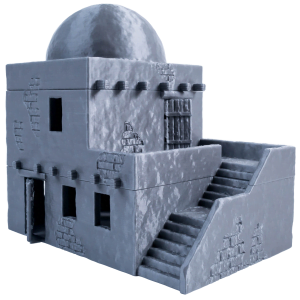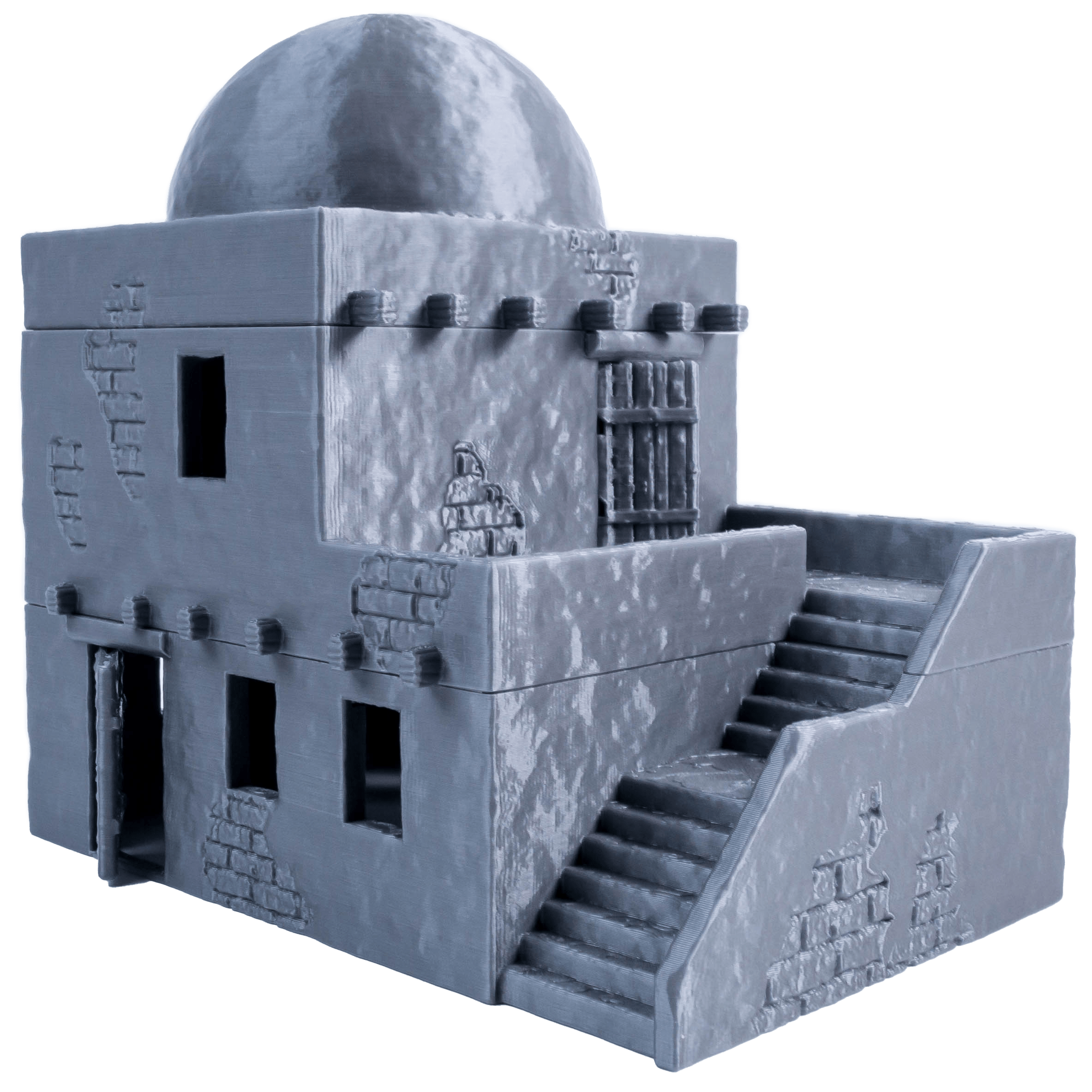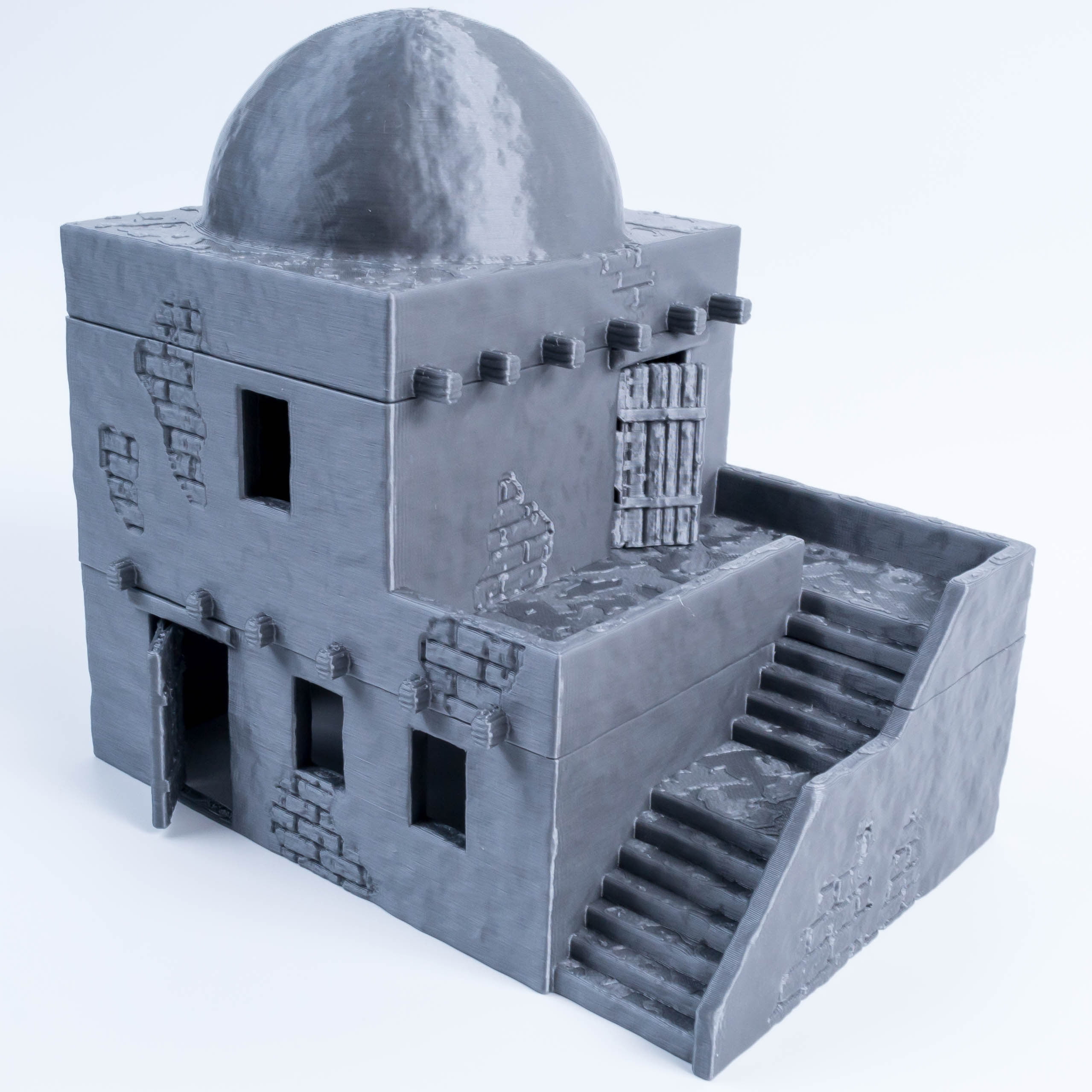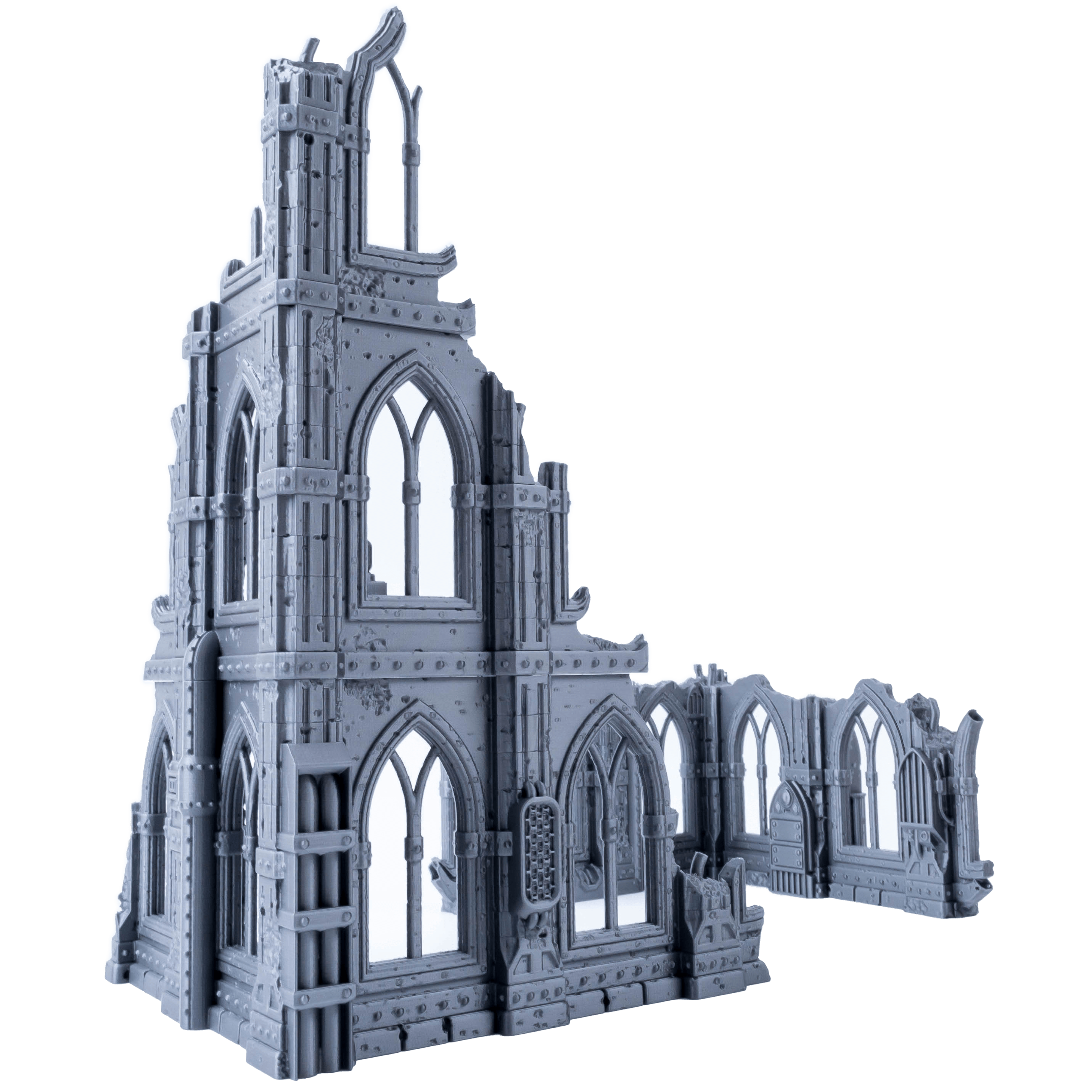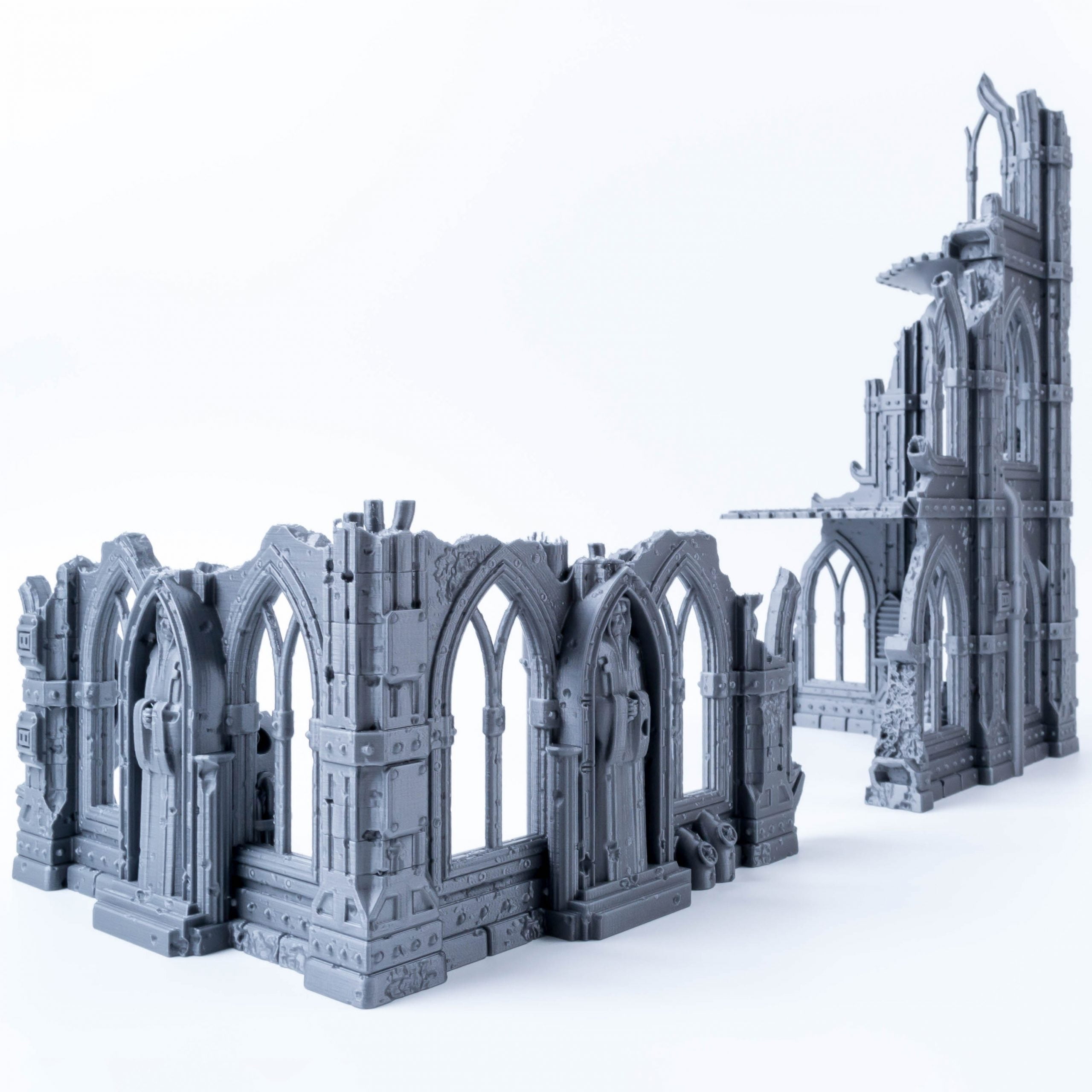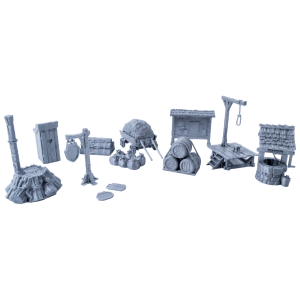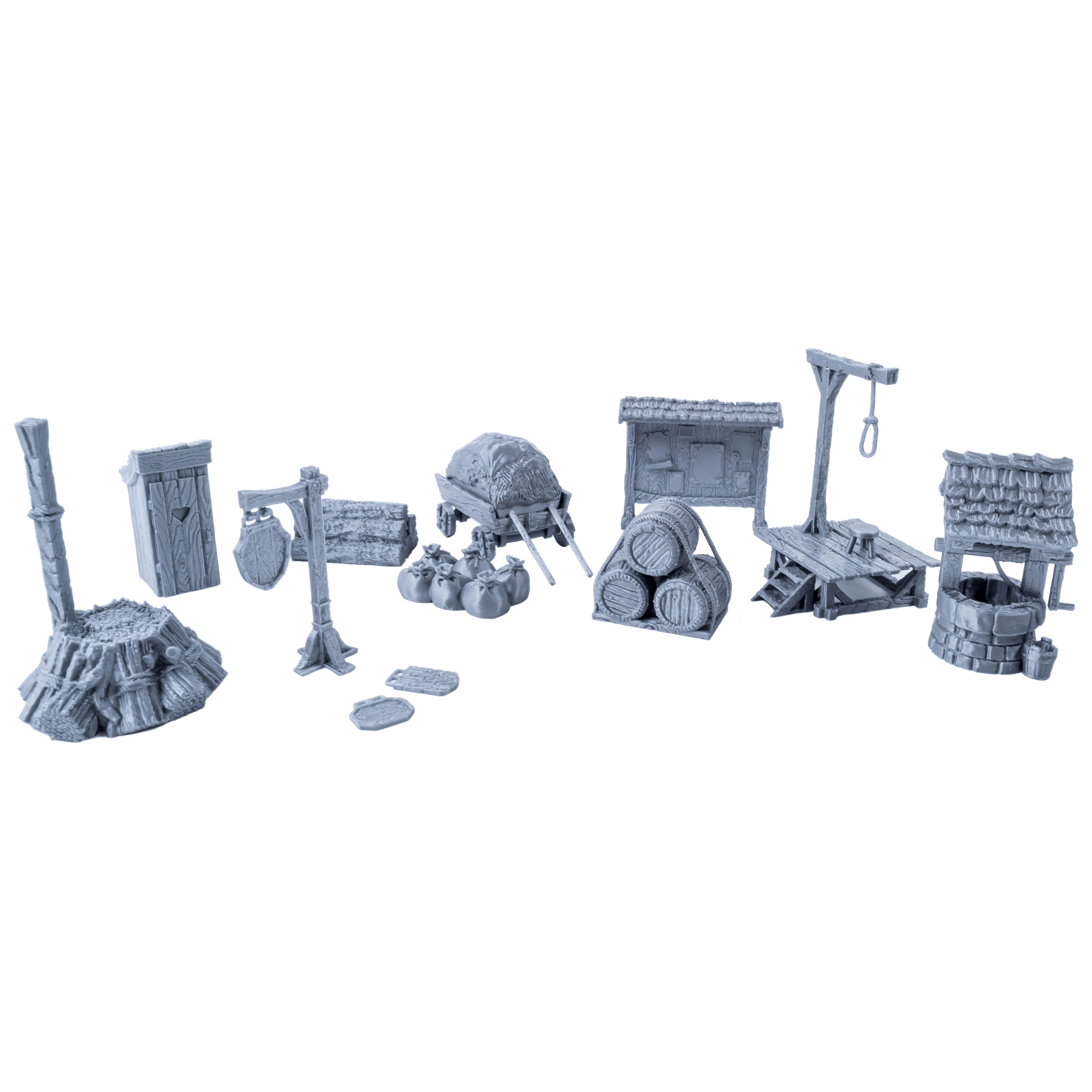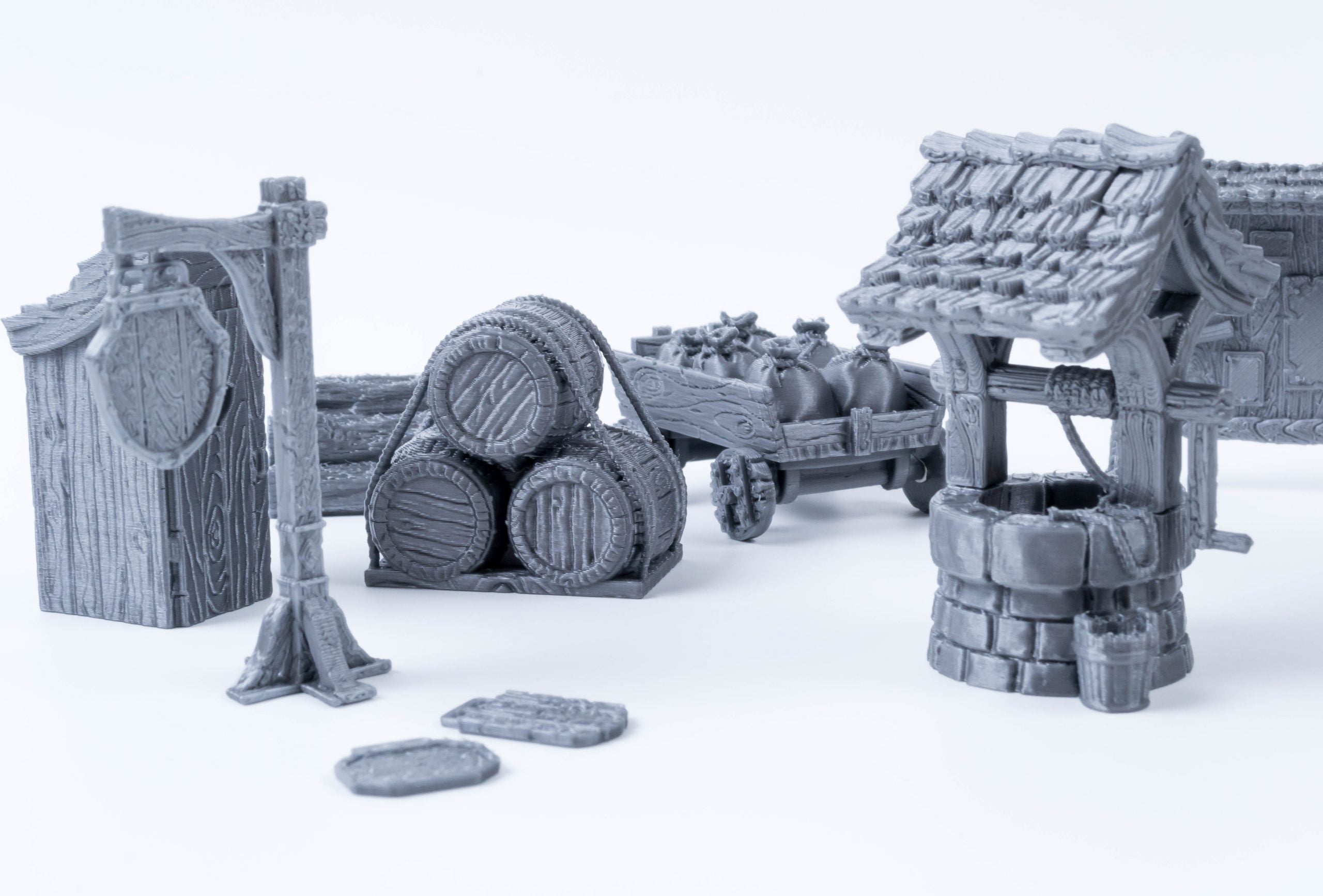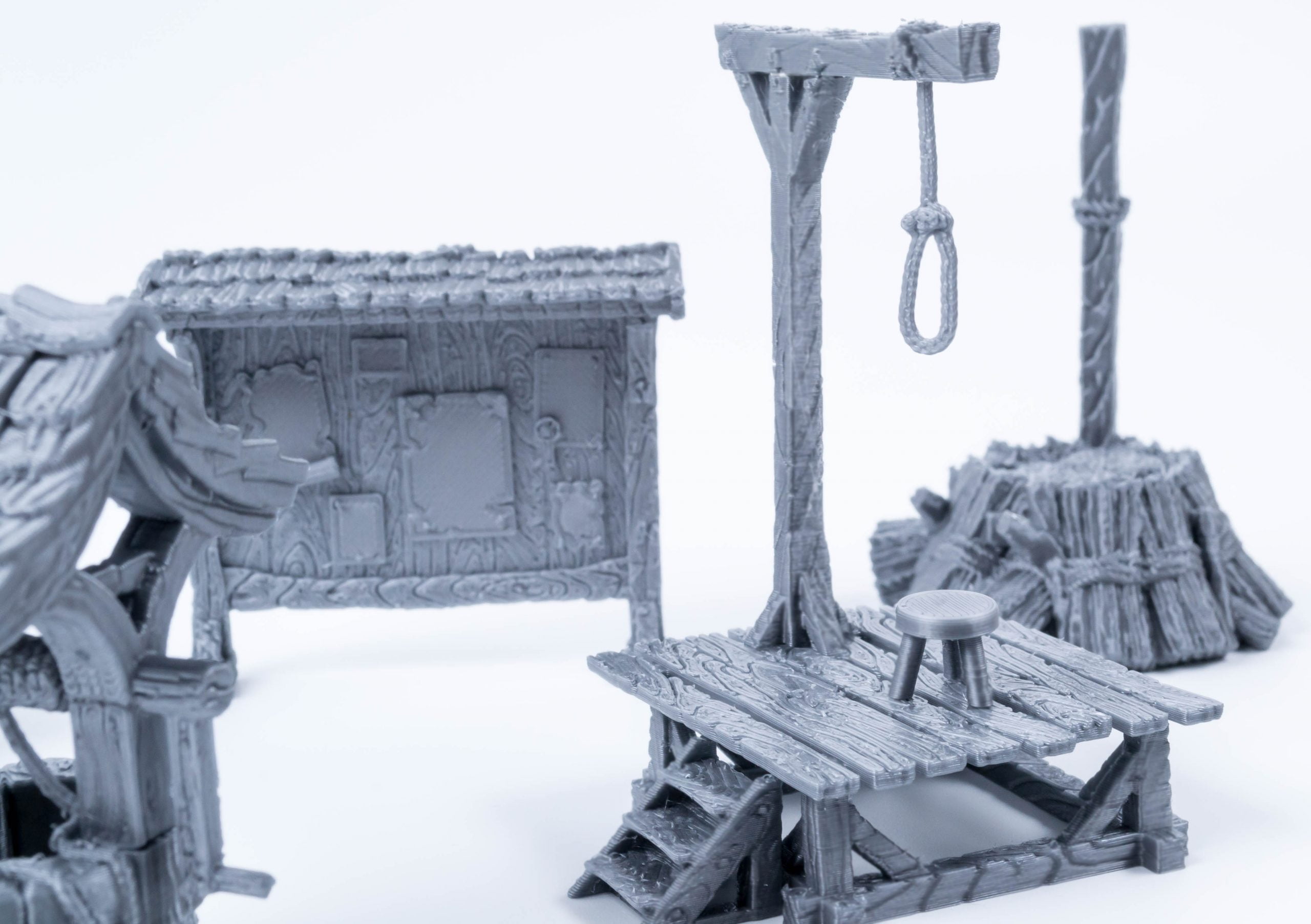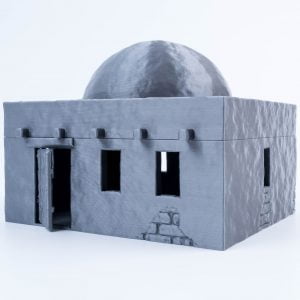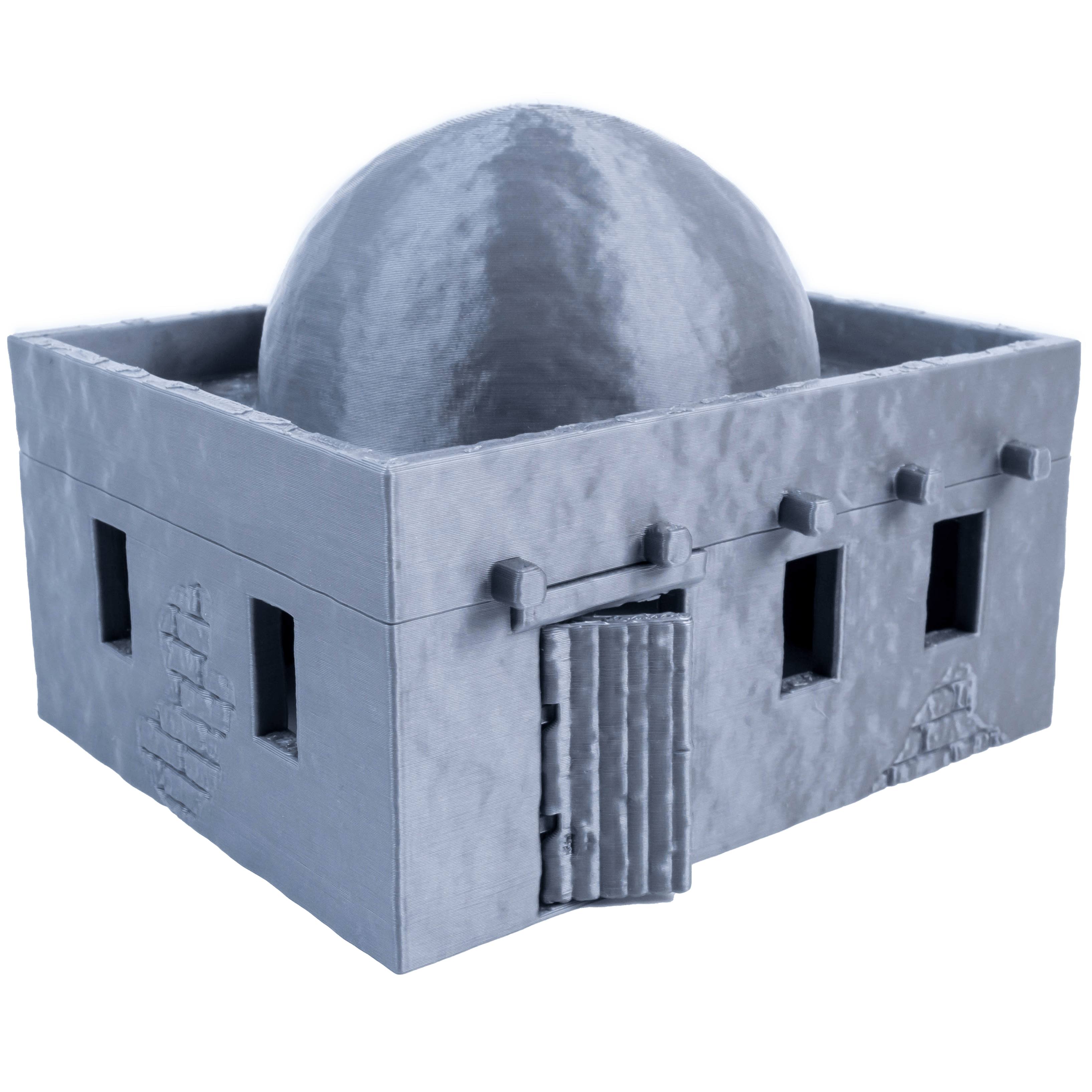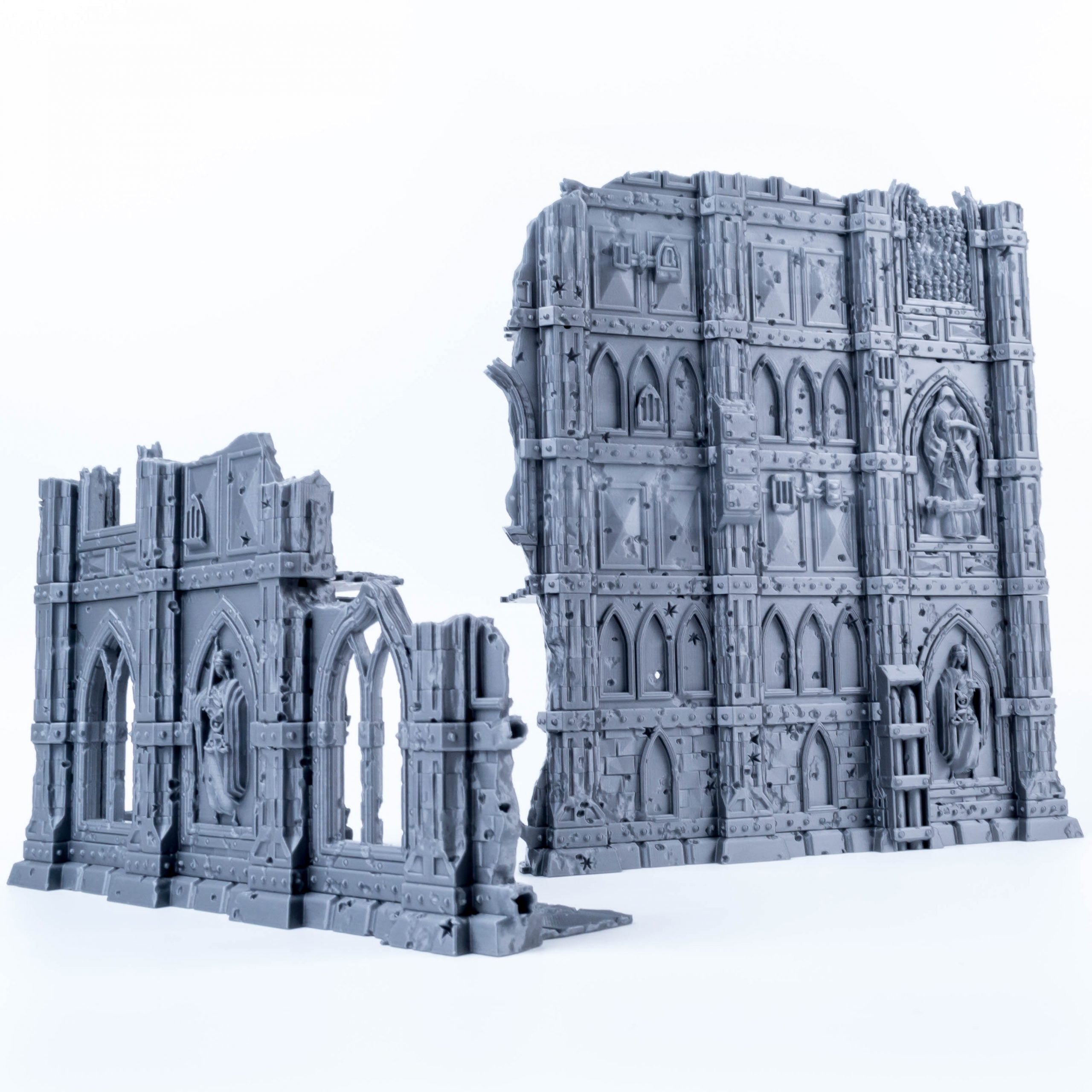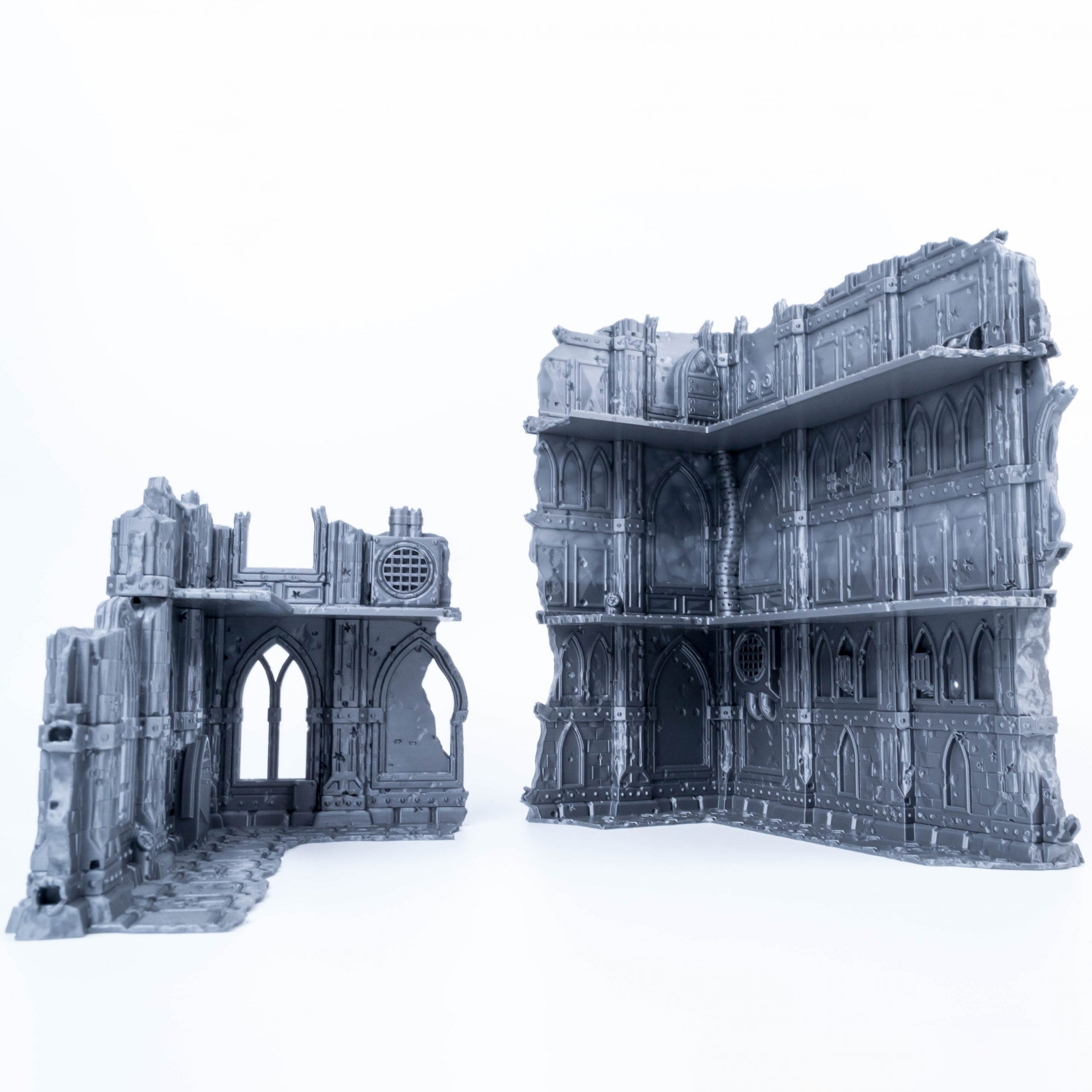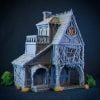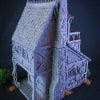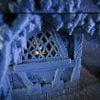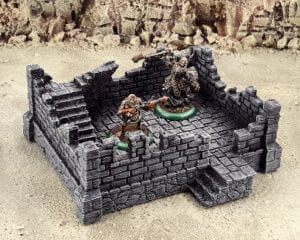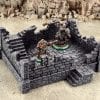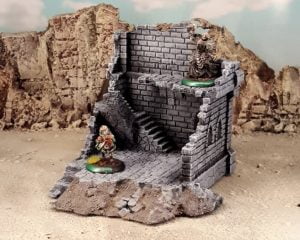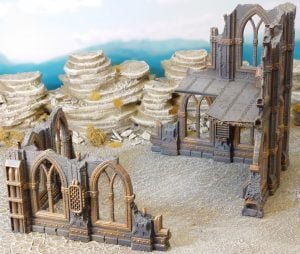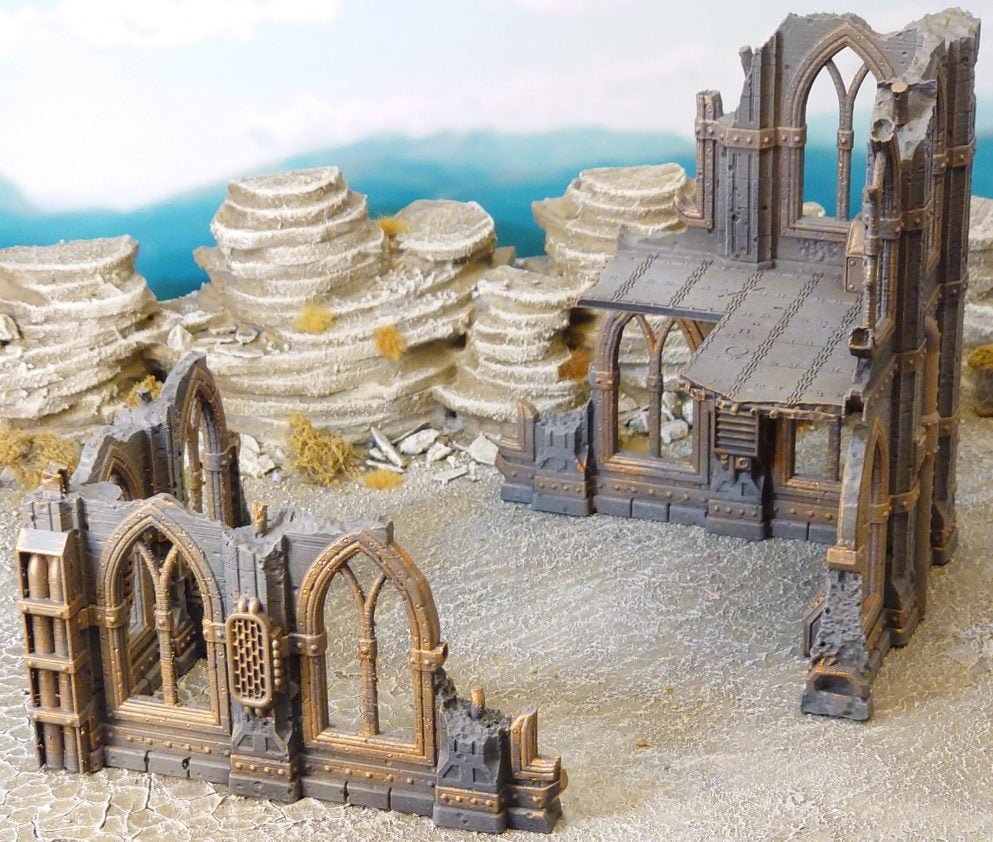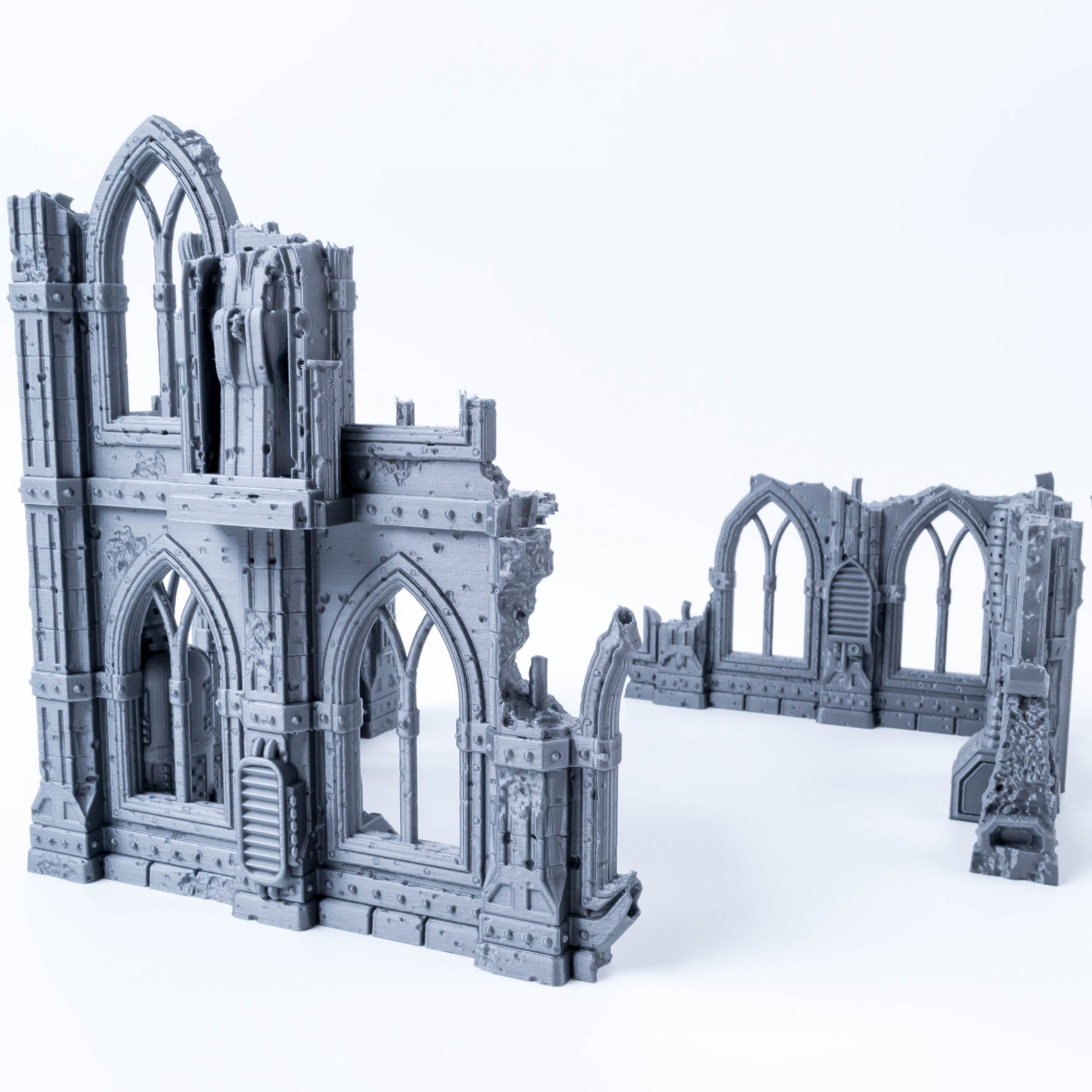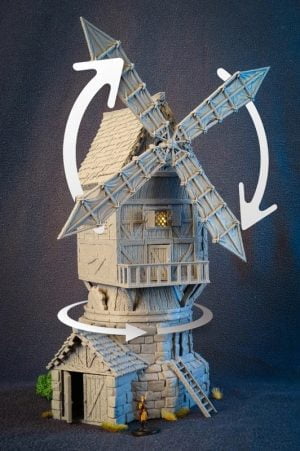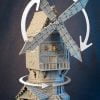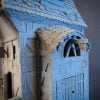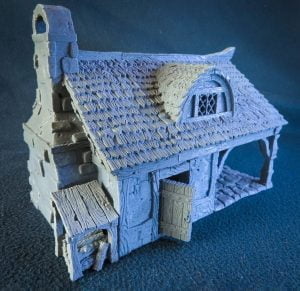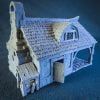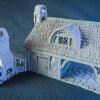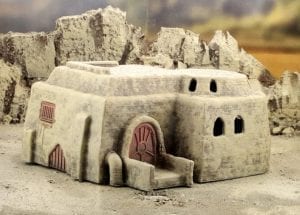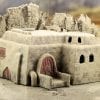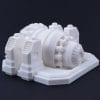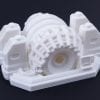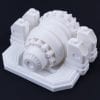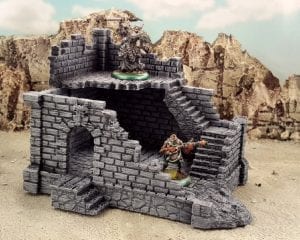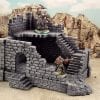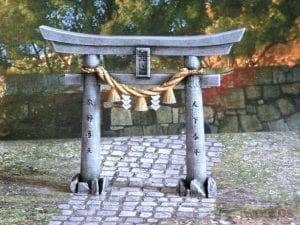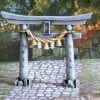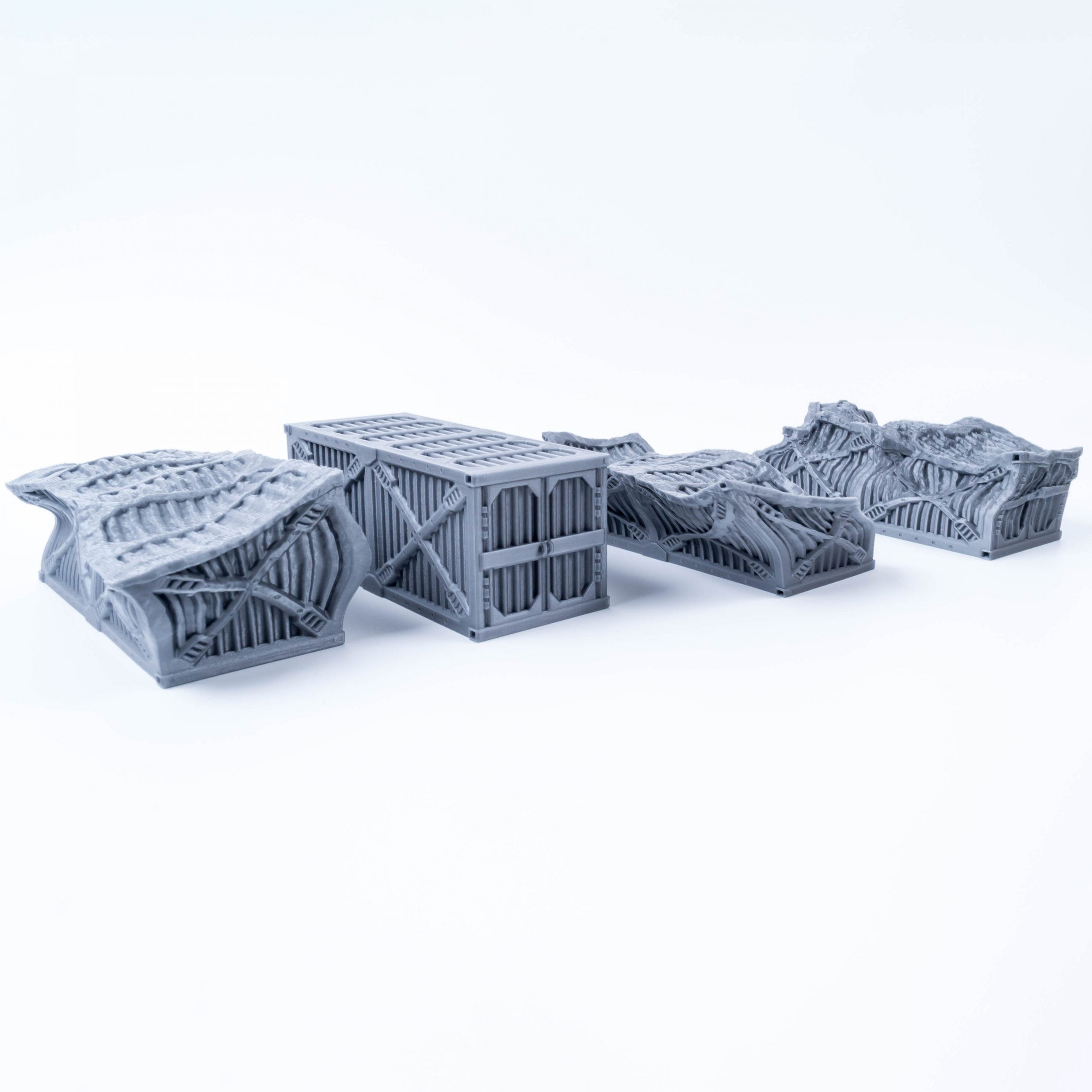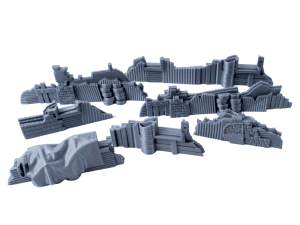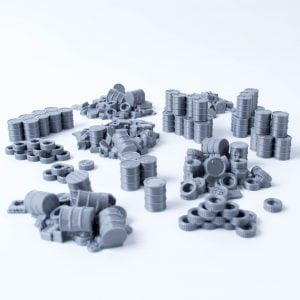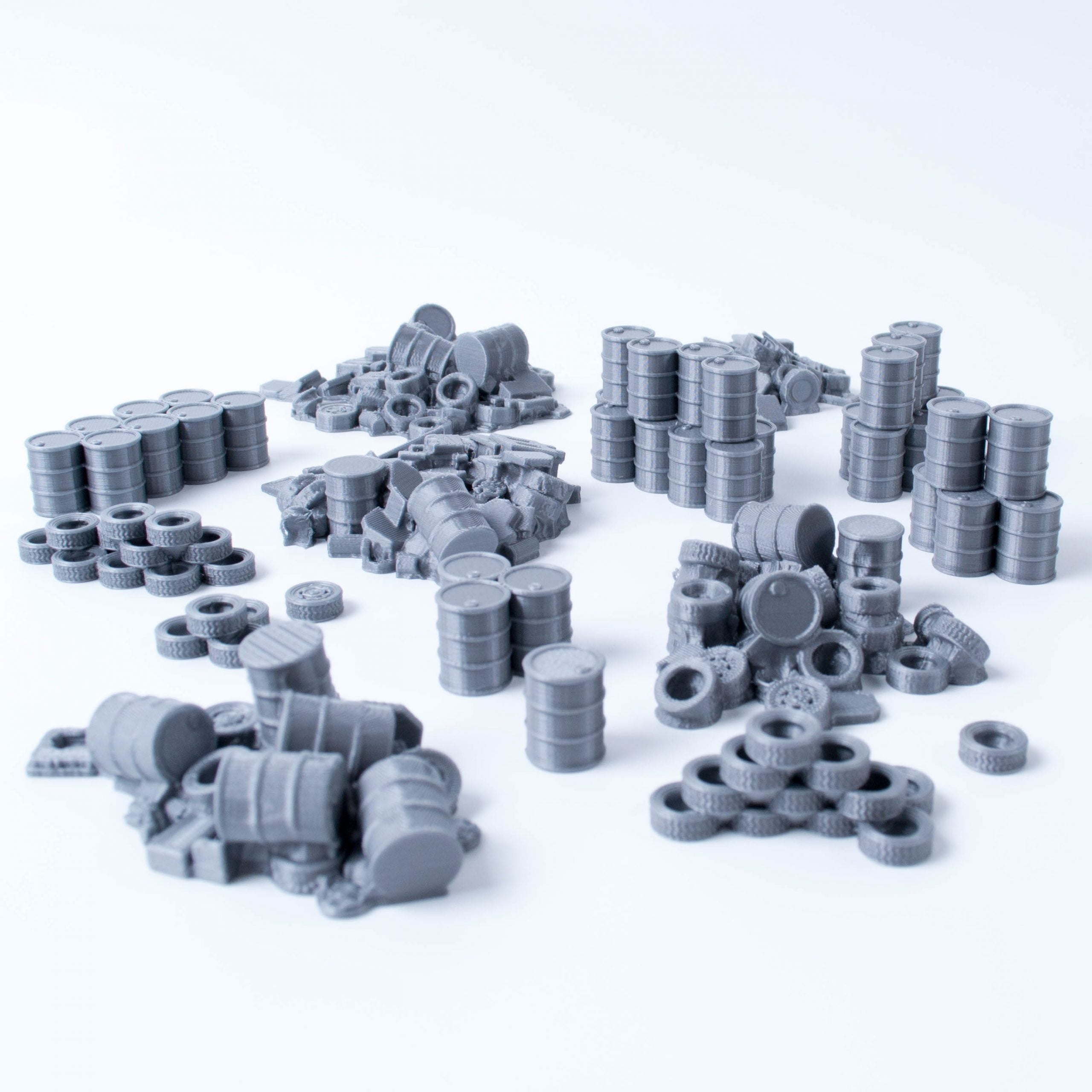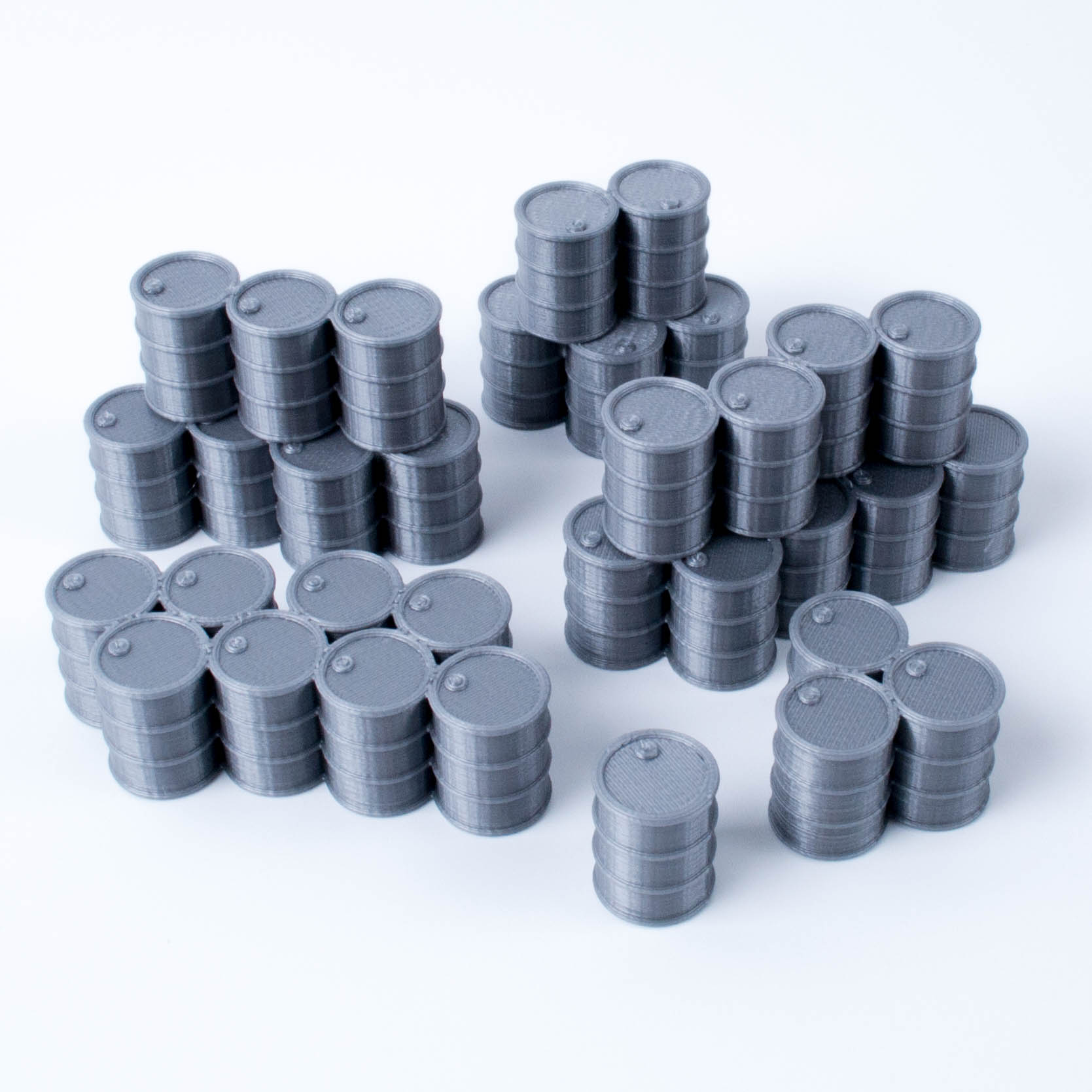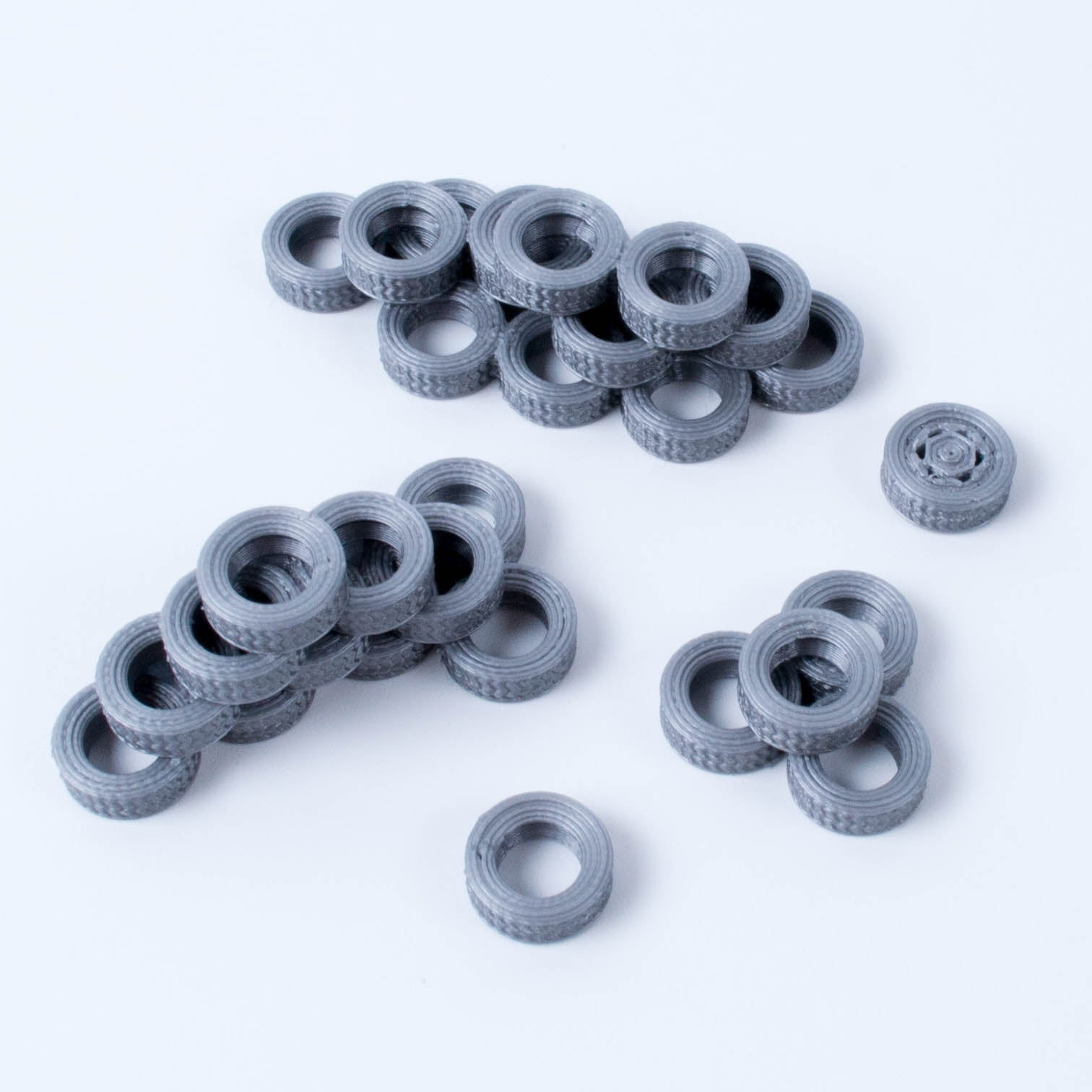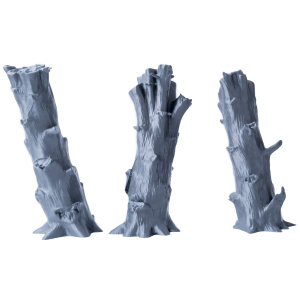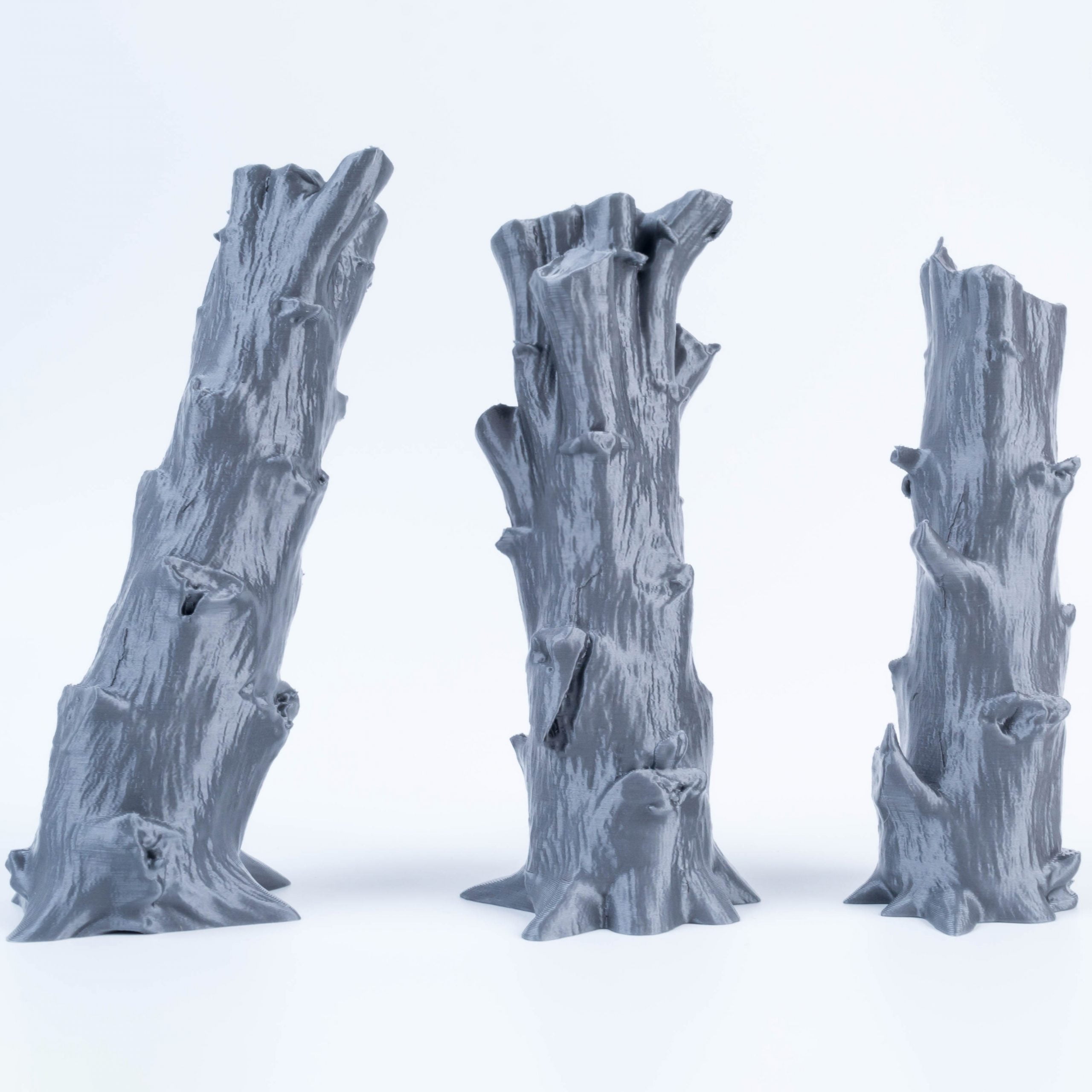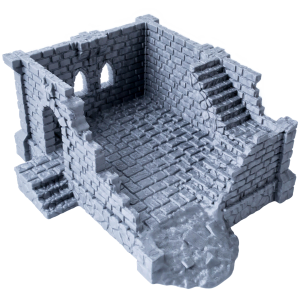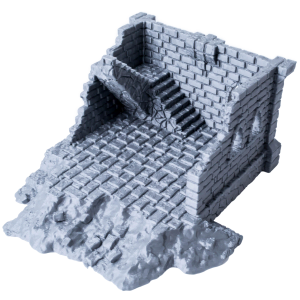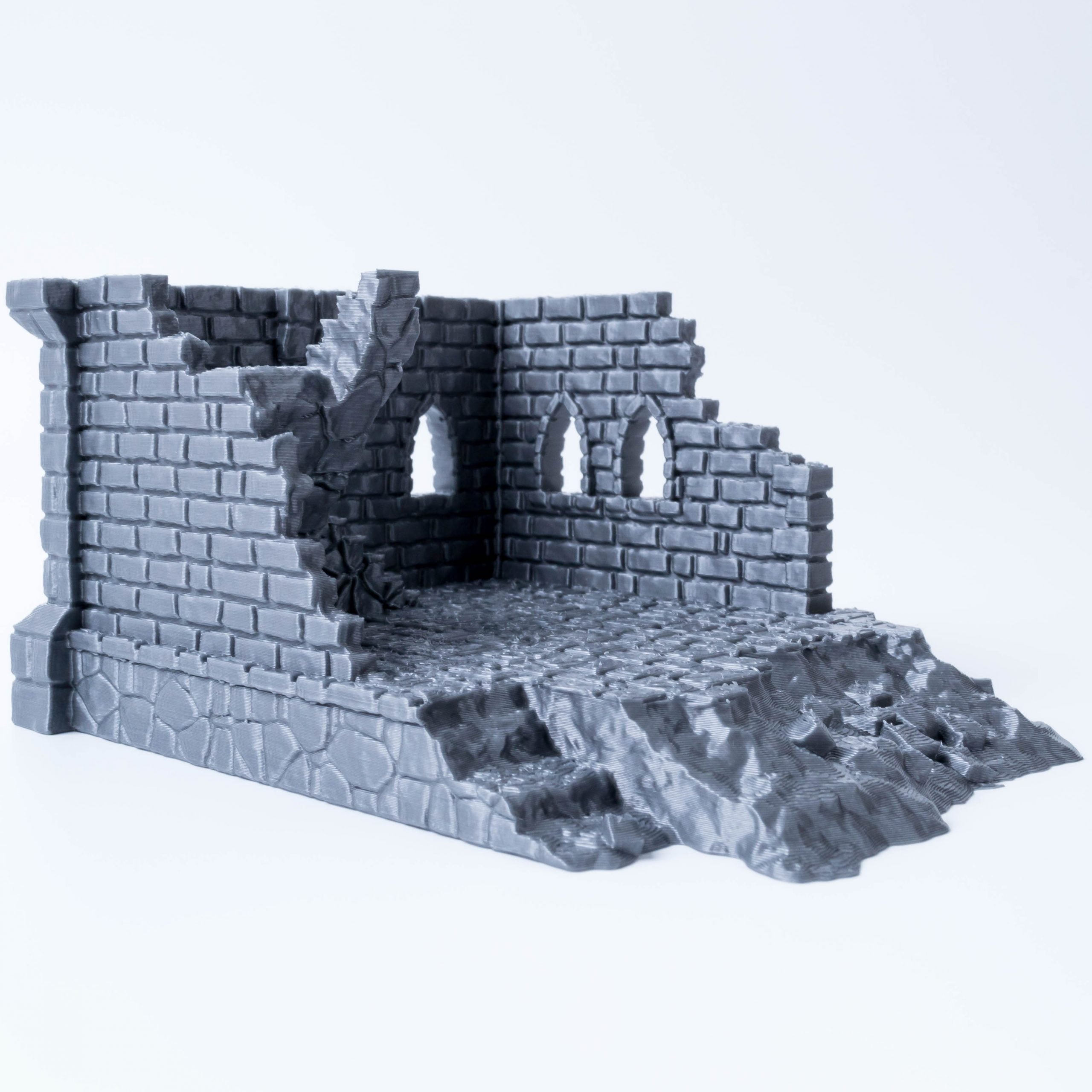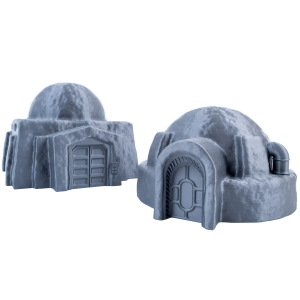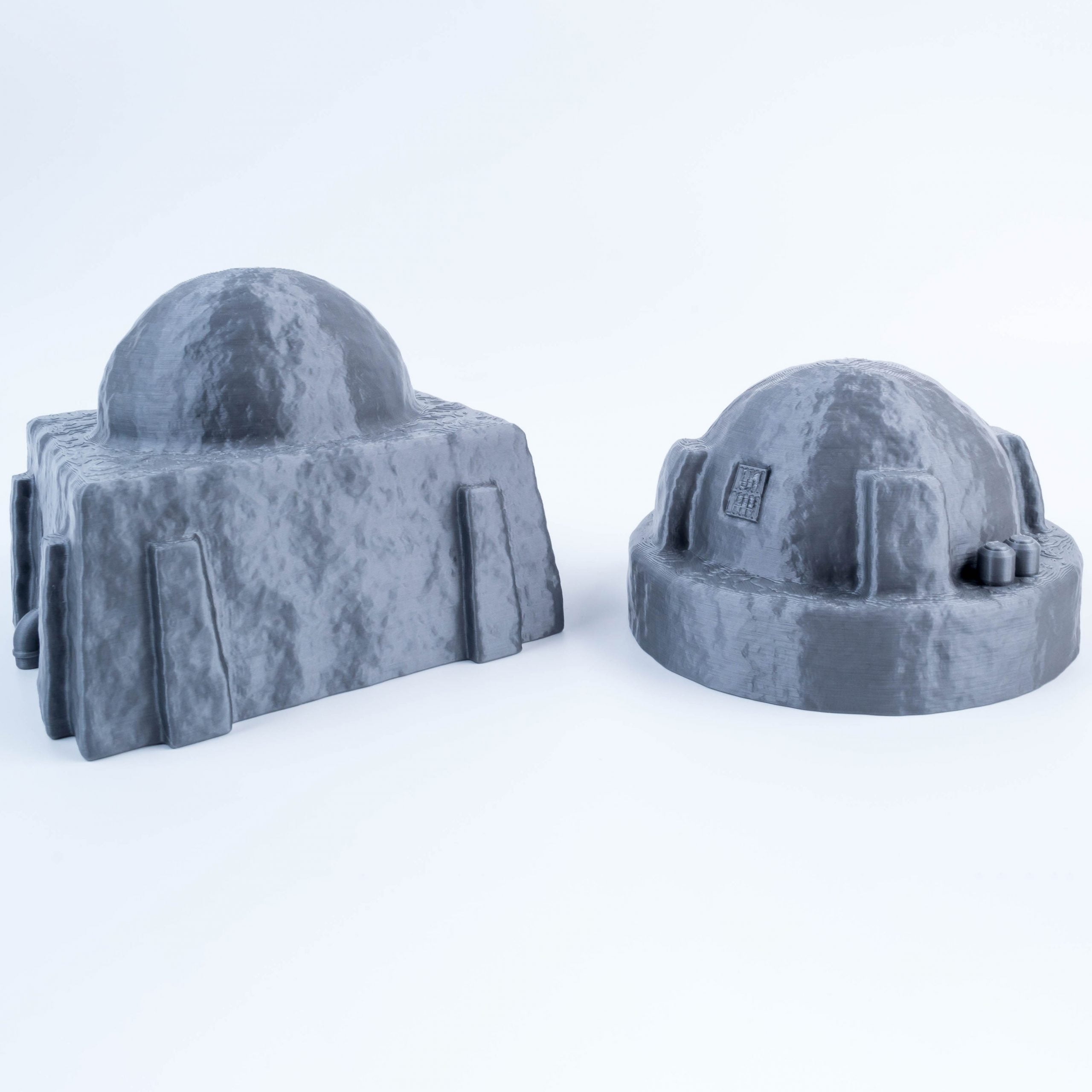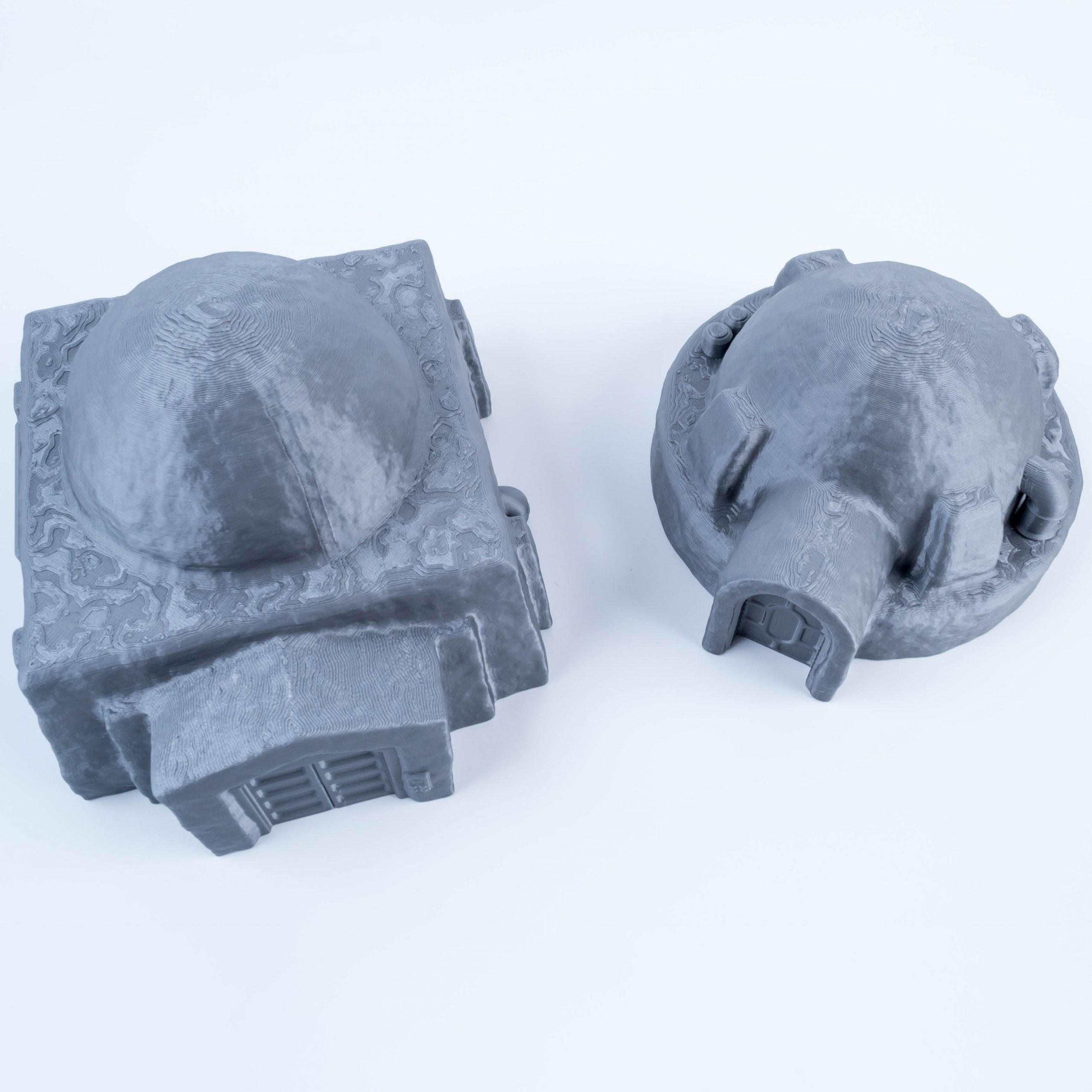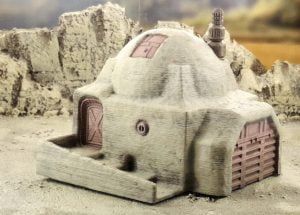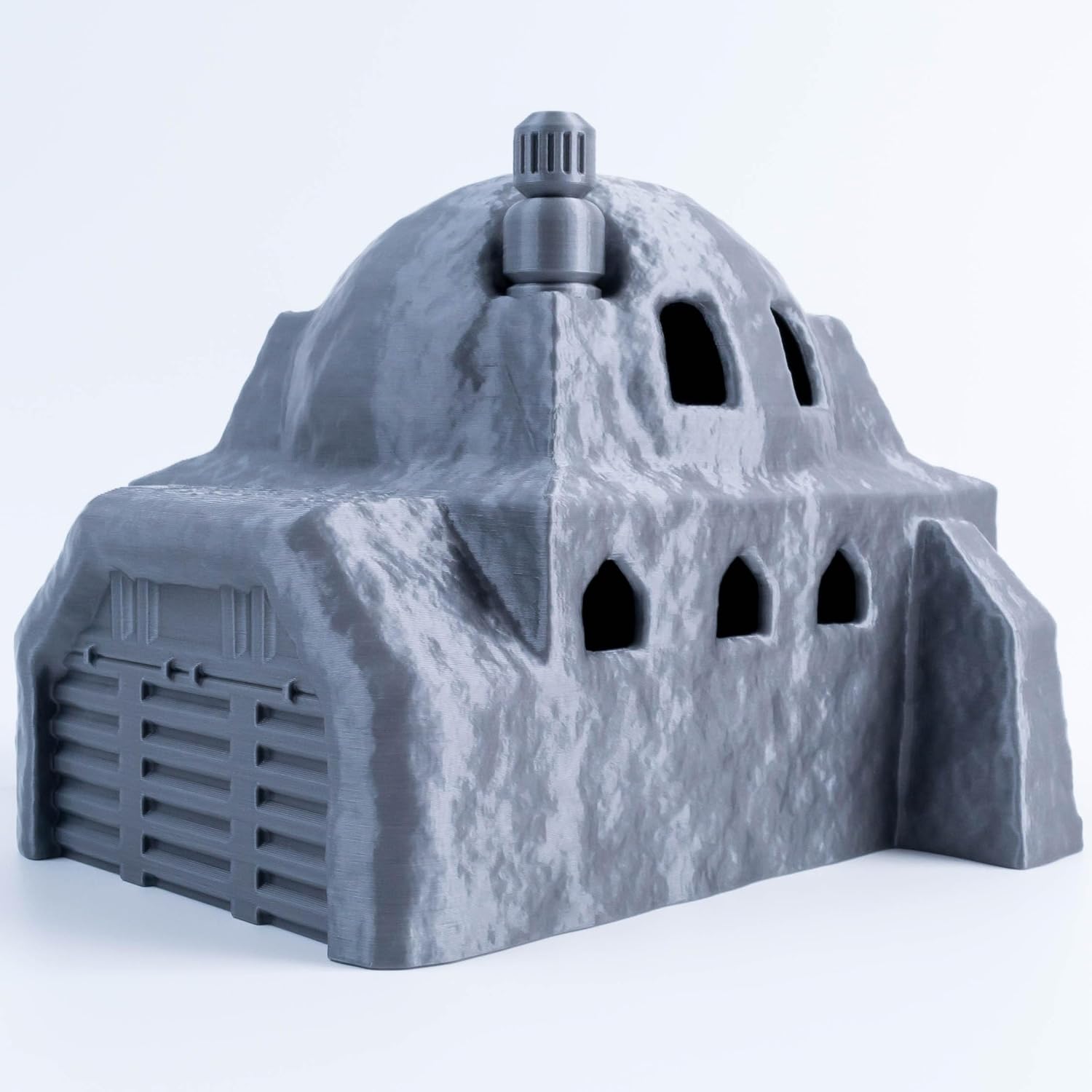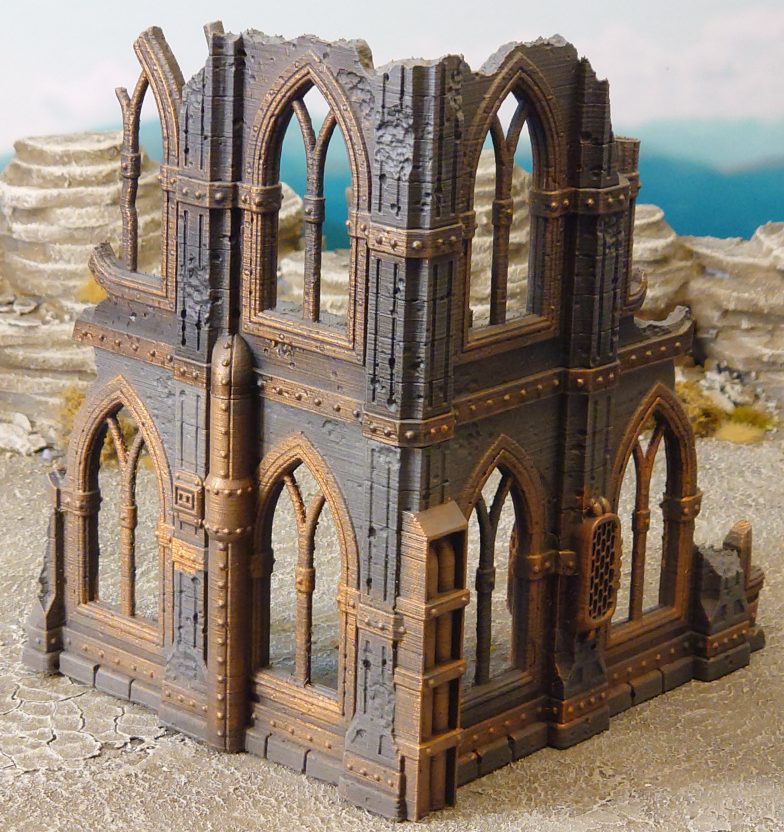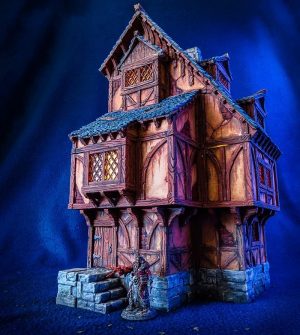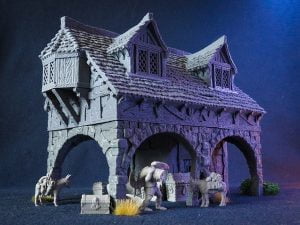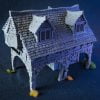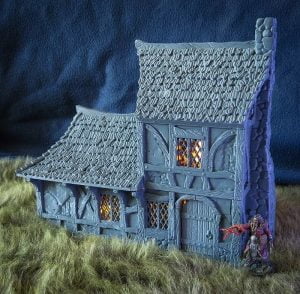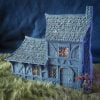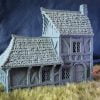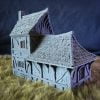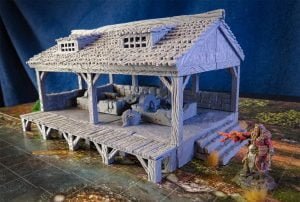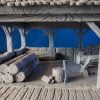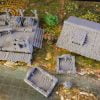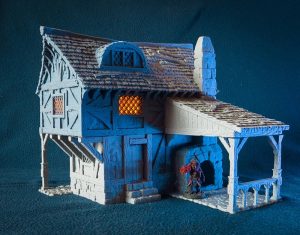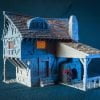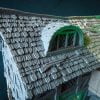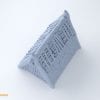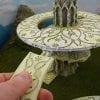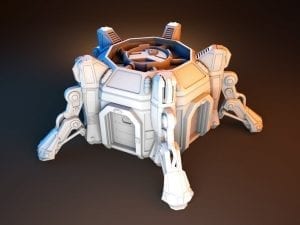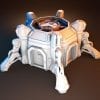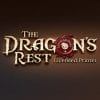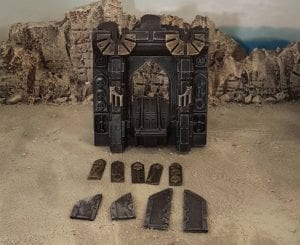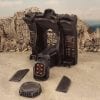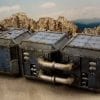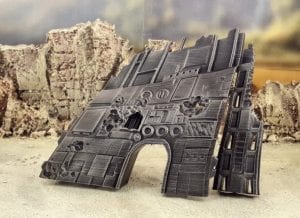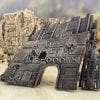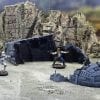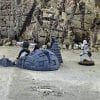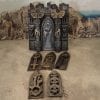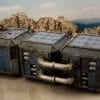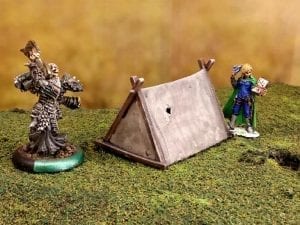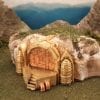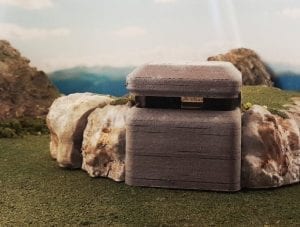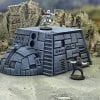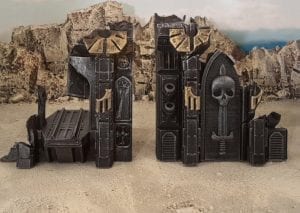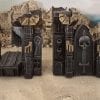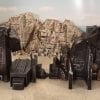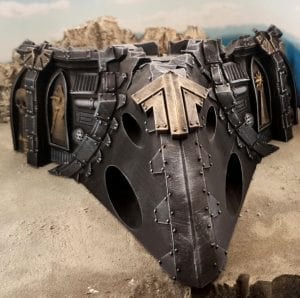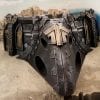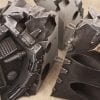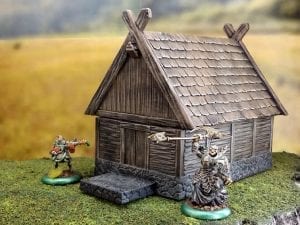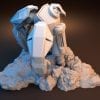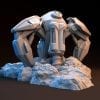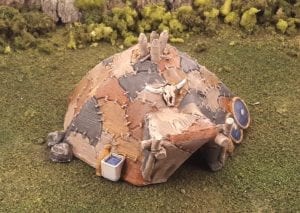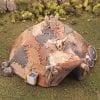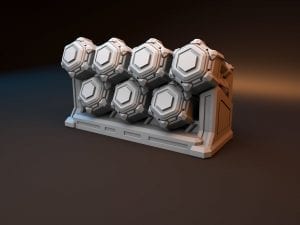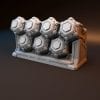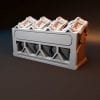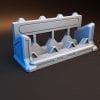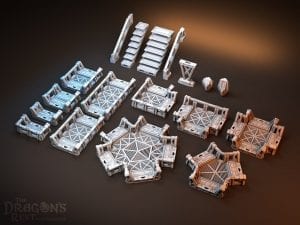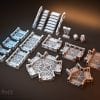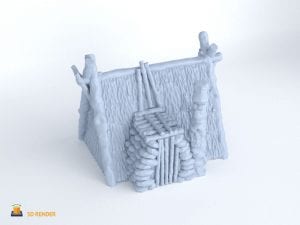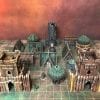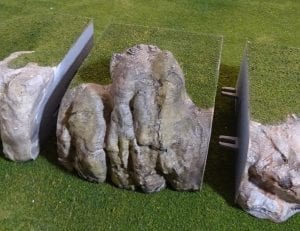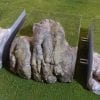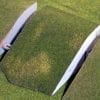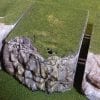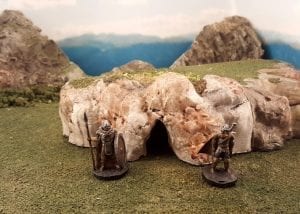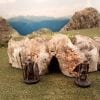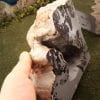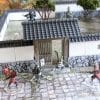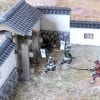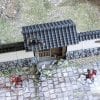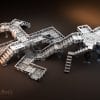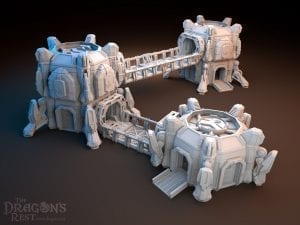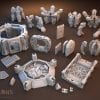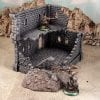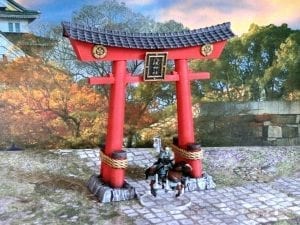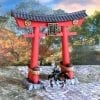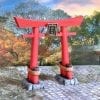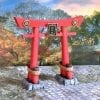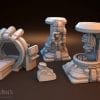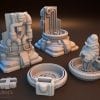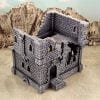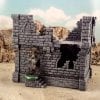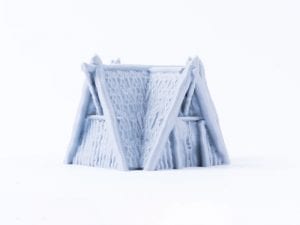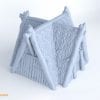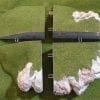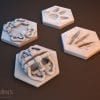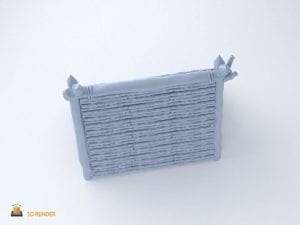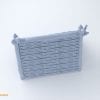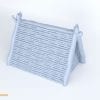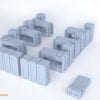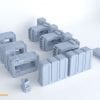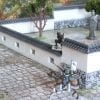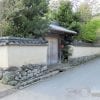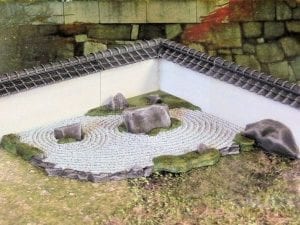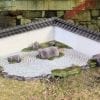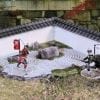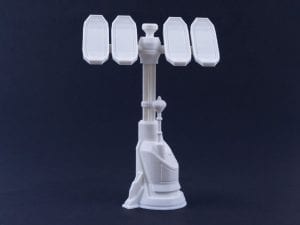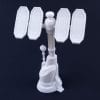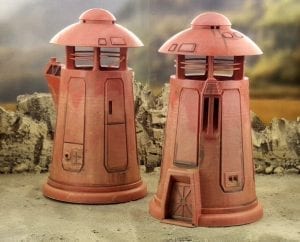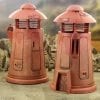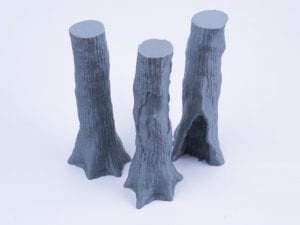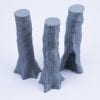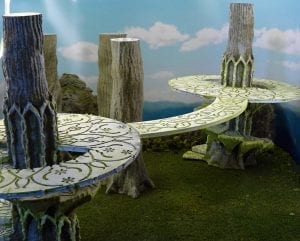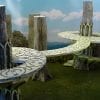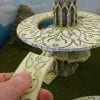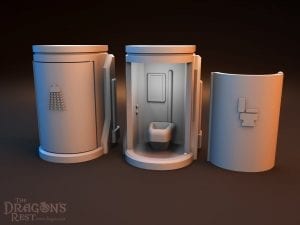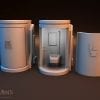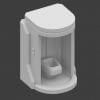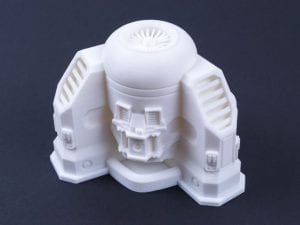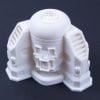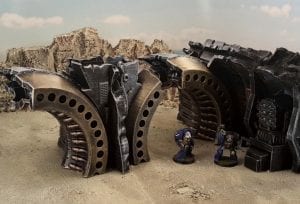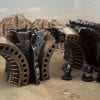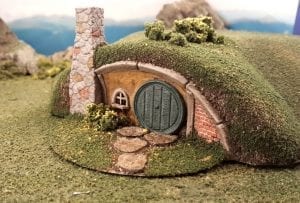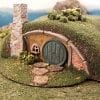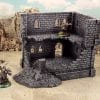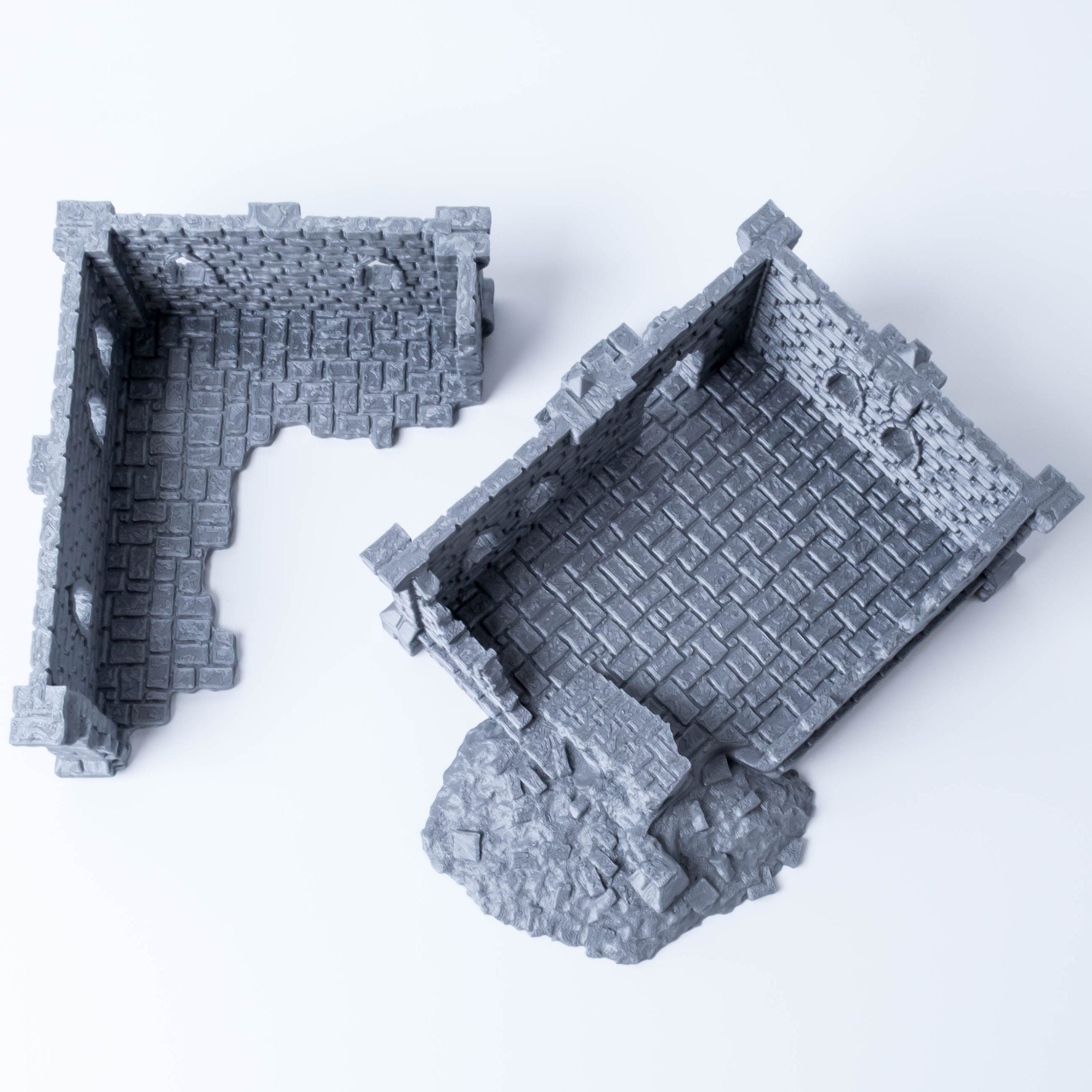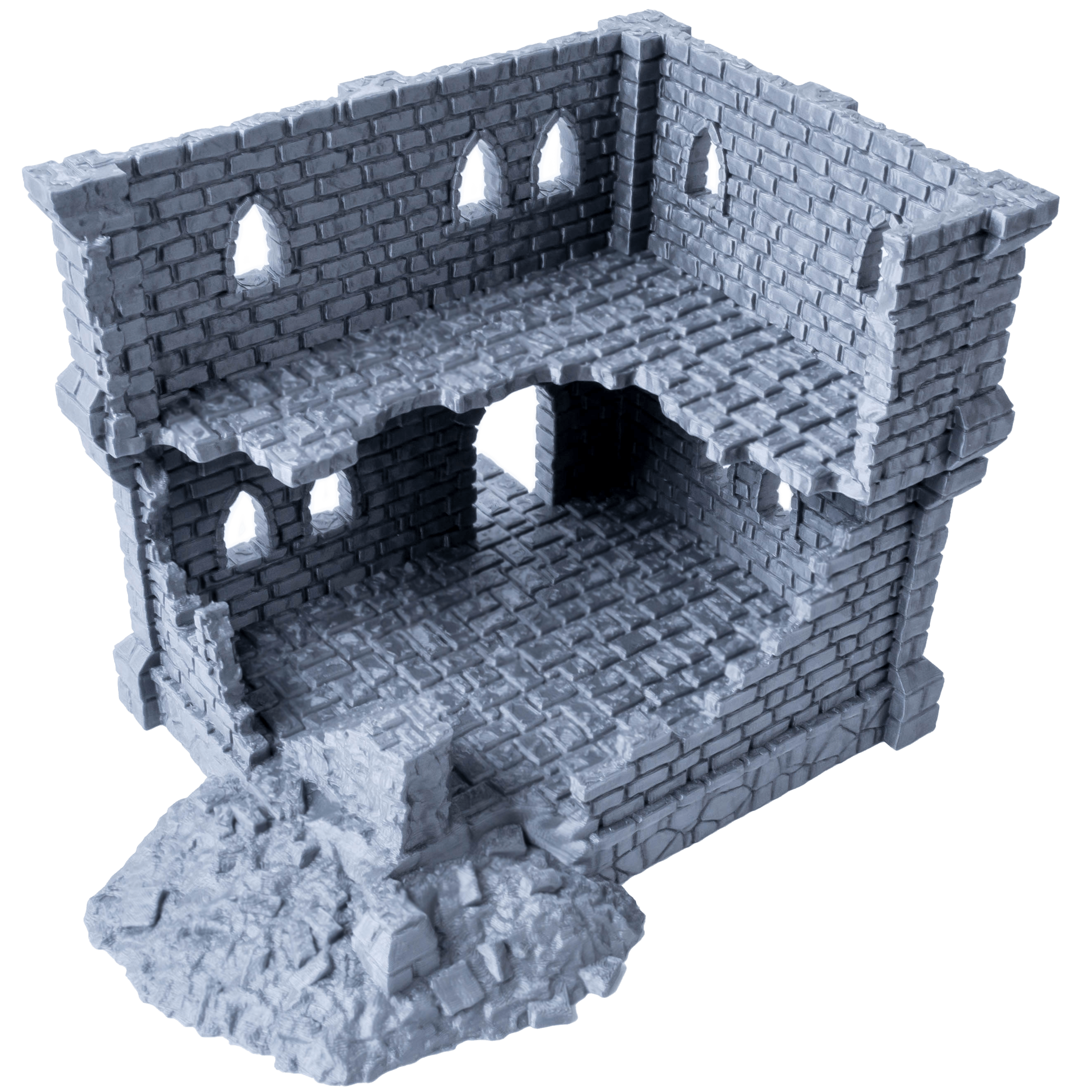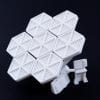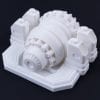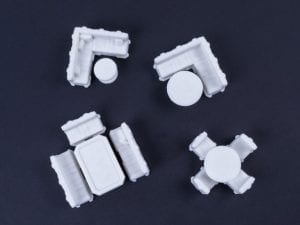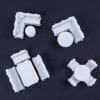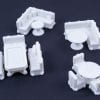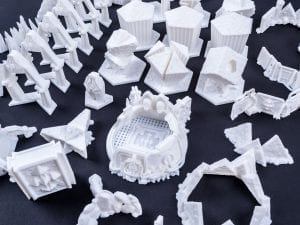Your cart is currently empty!
Terrain for Miniatures: The Ultimate Guide to Elevating Your Tabletop Games
Whether you’re a seasoned wargamer, avid Dungeons & Dragons adventurer, or new to the fantastic world of tabletop miniature games, terrain enhances the immersion and excitement of every adventure. Terrain pieces bring the battlefield to life, set the stage for thrilling strategic encounters, and provide a visual treat for all involved. This guide takes you through creating beautiful, functional, and budget-friendly terrain for your games.
Why Terrain Matters
- Immersion: Detailed terrain transforms a sterile flat surface into a dynamic play space, setting the tone and context for the action. A lush forest scene creates different combat strategies than an abandoned ruined city.
- Narrative Support: Terrain adds storytelling elements. Perhaps a toppled statue provides crucial cover, or an ominous broken bridge forces a daring gamble. It fosters imagination and richer play.
- Tactical Considerations: Carefully planned terrain offers challenges and strategic advantages. Line of sight, chokepoints, and cover become gameplay factors, pushing your mind beyond just the miniatures.
Types of Terrain
- Natural Environments: Recreate forests, jungles, swamps, deserts, and more using readily available materials and sculpting techniques. Think rocks, bark, twigs, moss…even aquarium decor!
- Urban Warfare: Design ruined buildings, barricades, and war-torn streets with cardstock, foam, or even recycled cardboard. This is ideal for wargaming or post-apocalyptic-themed settings.
- Dungeon Delving: Modular walls, doors, traps, and treasure chests bring classic dungeon crawls to life, allowing for dynamic layouts on game night.
- Specialty Terrain: Don’t forget unique thematic touches like craters for the moon’s surface, icy floes for an arctic battle, or alien landscapes for sci-fi settings.
Creating Your Own Terrain: DIY Strategies
- Simple & Accessible: Foamcore or cardboard forms the base for many structures. Cut to shape, layer for detail, and paint to taste!
- Textured Terrain: Model railroad supplies are a goldmine for realistic grit, flocking, and foliage options. Kitchen staples like baking soda and salt create stunning ground textures.
- Kitbashing: Combining model kits, toys, and found objects adds character and uniqueness. A shattered toy spaceship? Perfect as war-torn alien ruins!
Painting & Finishing Techniques
- Basecoating: A good primer is essential across materials. Then, block in main colors. Think brown earth, gray ruins, etc.
- Drybrushing: Brushing lightly dipped in lighter paint accentuates raised details and simulates wear for quick, effective texturing.
- Washes: Thinned-down paints or specialized washes flow into recesses for easy grime and shadows. Perfect for dirty, aged looks
- Details: Little splashes of vibrant color, weathering powders, or realistic weathering streaks draw the eye and further your storytelling.
Budget-Friendly Terrain Tips
- Recycle & Repurpose: Yogurt containers, broken electronics, and discarded packaging all hide terrain building potential. See the future before throwing things away!
- Dollar Store & Thrift Finds: You’d be surprised what simple toys, home decor items, and seasonal supplies become with a little creative paint and modification.
- Collaboration: Share building efforts with other gamers! A friend’s scrap material may be your perfect ruined archway.
Elevating Your Game
Well-crafted terrain for miniatures not only looks stunning but enhances your gaming experience dramatically. Imagine your miniatures perched on custom rocky outcroppings, maneuvering through meticulously built city streets, or facing monstrous challenges amongst a spooky, textured graveyard. It’s time to level up your table and your adventure!
Did we spark your imagination? Share your creations with us on social media – and enjoy losing yourself in the immersive world your hands create!
TERRAIN FOR MINIATURES
-
Sci-Fi
Star Wars Terrain Building: Unleash Galactic Adventures!
Star Wars terrain building, a captivating addition to your tabletop adventures. Immerse yourself in the iconic universe of Star Wars with this meticulously crafted terrain piece.
(0 reviews) -
Sci-Fi
Gothic Ruins Set 1: Miniature Terrain for Fantasy and Sci-Fi Games
Are you ready to enter a world of history and desolation? A world where the ruins of a once glorious building stand as a silent witness to the wars and ages that have passed? If so, then you will love the Gothic Ruins Set, the ultimate set for creating a stunning and immersive scene for your tabletop games and RPGs.
(0 reviews) -
Terrain & Scenery
City Items Set: Versatile Scatter Terrain for Tabletop RPGs & Wargames (28/32mm)
Lose yourself in the captivating realism of your 28/32mm miniature worlds! This set offers a wealth of potential, serving as essential scatter terrain, evocative D&D scatter terrain, or captivating additions to miniature base terrain. Whether crafting fantasy villages, historical cities, or gritty underworlds, each PLA piece injects handcrafted detail and fuels endless gaming narratives.
(0 reviews) -
Sci-Fi
Journey to an Oasis: Simple Domed Residence for Arabic Scenery
Star Wars terrain building, a captivating addition to your tabletop adventures. Immerse yourself in the iconic universe of Star Wars with this meticulously crafted terrain piece.
(0 reviews) -
Sci-Fi
Domina Ferrum Ruins Set: Gothic Ruins Terrain
This set features stunning gothic ruins terrain pieces that are perfect for games like Warhammer 40k. You can build your own grim dark cityscape with these modular ruins, and create epic battles in a dystopian future.
(0 reviews) -
Buildings and Tents
Healer’s house 28mm scale building for medieval and fantasy village. City of Tarok
You can open and close the doors of this medieval healer house to make your tabletop more alive. All the cracks and every detail is modeled individually. You’ll find a few repeating patterns on this model.
Rated 5.00 out of 5(4 reviews) -
Buildings and Tents
Bare Stone Ruined Building for WWII or Fantasy Wargames (One Piece)
If you’re looking for a simple and versatile terrain piece for your WWII or fantasy wargames, you’ll love this bare stone ruined building. This model is a one piece structure that can be easily placed on your tabletop.
(0 reviews) -
Buildings and Tents
Two-Level 28mm Fantasy Ruins for Epic Adventures
This meticulously crafted terrain piece transcends mere scenery, offering an immersive battleground for medieval skirmishes, fantastical quests, and thrilling Frostgrave encounters.
(0 reviews) -
Sci-Fi
Gothic Ruins Set 2: Ruined Cathedral for Fantasy and Sci-Fi Games
The Ruined Cathedral consists of three modular pieces that can be arranged in different ways to suit your needs. You can stack them up to form a towering structure that dominates the landscape, or you can use them individually to create a smaller ground-level ruin that provides shelter and intrigue. You can also combine them with other sets from Gothic Ruins Set to create endless variations.
(0 reviews) -
Buildings and Tents
Windmill 28mm scale building for medieval and fantasy village. City of Tarok
The wheel and the top part is turnable! And you can open and close the doors to make your tabletop more alive. All the cracks and every detail is modeled individually. You’ll find a few repeating patterns on this model.
Rated 4.78 out of 5(9 reviews) -
Buildings and Tents
Cottage and Bakery 28mm scale building for medieval and fantasy village. City of Tarok
Rated 5.00 out of 5(2 reviews) -
Sci-Fi
Desert Sci-Fi Star Wars Legion Compatible Building 28mm 32mm scale
This building is designed to fit perfectly with Star Wars Legion and other RPG miniatures (Star Wars, Dungeons & Dragons, Pathfinder), Warhammer, or other tabletop games. It features a detailed and sturdy structure, with a dome-shaped roof, a circular entrance, and windows. The building has a sandstone-like texture, and comes in gray color giving it a realistic desert look.
(0 reviews) -
Sci-Fi
Desert Terrain Building 28mm Scale
This 28mm scale terrain is compatible with other RPG miniatures like D&D, Pathfinder, and Imperial Assault. It is designed to fit the theme and style of Star Wars Legion, a tabletop game that lets you recreate epic battles from the Star Wars saga.
(0 reviews) -
Sci-Fi
Sci-Fi Utilities Set 28mm Scale
This scenery set includes the following items:
1 x Comms Tower (w129 x d61.38 x h185.37 mm)
1 x Solar Array Size (w177.62 x d183.08 x h144.03 mm)
1 x Oxygen Pump Size (w82 x d127 x 91 mm)
1 x Power Generator Size (w138 x d152 x h70 mm)(0 reviews) -
Buildings and Tents
28mm Medieval Terrain: Ruined Stone Building
If you’re looking for a realistic and immersive terrain piece for your medieval or fantasy wargames, you’ll love this ruined stone building. This model comes in two parts (top and bottom) that can be easily assembled and disassembled for storage and transport.
(0 reviews) -
Terrain & Scenery
Torii Gates From Old Japan 28mm Scale
This is a stone torii gate, typically found in local shrines and rustic locations. The stone torii gate features plain pillars, another version with engraved kanji on the pillars, and a third version with rope and paper tassles.
The items will come unpainted. Printed white.
Rated 5.00 out of 5(1 review) -
Terrain & Scenery
Wargaming Shipping Containers: for Your Wargaming Battlefields (4-Piece Set)
Transform your tabletop into a desolate warzone or industrial wasteland with these 28mm wargaming shipping containers. Designed specifically for 28mm and 32mm scale wargames, this 4-piece set adds gritty realism, cover opportunities, and tactical depth to your Warhammer 40k, Necromunda, Kill Team, Infinity, or any modern/sci-fi skirmish.
(0 reviews) -
Terrain & Scenery
Shanty Obstacle Set: Build Gritty Battlescapes for Your Miniatures
The sprawling underbelly of empires teems with life… and conflict. Whether it’s the desperate haven of scavengers in a fallen hive city or the fortified wreckage claimed by brutal gangs, this 7-piece shanty obstacle set brings those desperate, make-shift structures to your tabletop.
(0 reviews) -
Terrain & Scenery
Industrial Rubble Scatter Terrain: Immersive Warhammer 40k Battlefields (28mm)
Amidst the endless wars of the 41st millennium, even the mightiest industrial hubs crumble… makin’ da perfect lootin’ grounds for any self-respectin’ Ork Waaagh! This massive 16-piece Warhammer 40k scatter terrain set brings scrap heaps, busted walkways, and toppled war machines straight to yer tabletop. It’s an entire battlefield just waitin’ to become an Ork playground! Each bit o’ metal is a story of fallen industry – but more importantly, it’s potential loot, buildin’ material, and scrap to settle arguments da good ol’ fashioned way.
(0 reviews) -
Terrain & Scenery
Tree Terrain Set (28/32mm) for Tabletop RPGs & Wargames
Escape into dense forests, create tactical cover with twisting branches, and add stunning realism to your games! This set of expertly crafted PLA trees delivers the natural touch your miniature adventures deserve. Whether you wage war in Warhammer 40k or Age of Sigmar, explore dungeons in D&D, or forge narratives across countless worlds, these trees will amplify your immersion.
(0 reviews) -
Buildings and Tents
Stone Ruined Outpost: 28mm Fantasy Ruins for Epic Adventures
Forged from the fires of imagination and crafted with meticulous detail, the Ulvheim Ruins Series: Stone Ruined Outpost transports your tabletop adventures to a realm of forgotten stories and thrilling encounters.
(0 reviews) -
Buildings and Tents
One-Level 28mm Fantasy Ruins for Epic Adventures
This meticulously crafted terrain piece transcends mere scenery, offering an immersive battleground for medieval skirmishes, fantastical quests, and thrilling Frostgrave encounters.
(0 reviews) -
Sci-Fi
Desert Sci-Fi Outposts: Build Your Own Sci-Fi Oasis
Star Wars terrain building, a captivating addition to your tabletop adventures. Immerse yourself in the iconic universe of Star Wars with this meticulously crafted terrain piece.
(0 reviews) -
Sci-Fi
Sci-Fi Habitat – Desert Sci-Fi Building for the Sci-Fi Explorer in You
Futuristic Design: Our terrain pieces are sleek, modern, and galactic-inspired—perfect for sci-fi themed gaming. Picture towering spires, angular walkways, and holographic interfaces—the very essence of a future where technology dances with the cosmos.
(0 reviews) -
Sci-Fi
Gothic Ruins Set 3: Crumbling Abbey for Fantasy and Sci-Fi Games
The Crumbling Abbey is made of three separate pieces that you can arrange in different ways to create your own custom ruins. You can make a tall and majestic building that stands out from the rest, or you can make a low and cozy ruin that blends in with the surroundings. You can also mix and match them with other pieces from the Gothic Ruins Set to create endless combinations.
(0 reviews) -
Buildings and Tents
Medieval Home 28mm scale building for medieval and fantasy village. City of Tarok
You can open and close the doors of this medieval house to make your tabletop more alive. All the cracks and every detail is modeled individually. You’ll find a few repeating patterns on this model.
Rated 5.00 out of 5(3 reviews) -
Buildings and Tents
Merchant’s house and Prison 28mm scale building for medieval and fantasy village. City of Tarok
You can open and close the doors of this miniature building to make your tabletop more alive. All the cracks and every detail is modeled individually. You’ll find a few repeating patterns on this model.
Rated 4.43 out of 5(7 reviews) -
Buildings and Tents
Small House 28mm scale building for medieval and fantasy village. City of Tarok
You can open and close the doors of this small house to make your tabletop more alive. All the cracks and every detail is modeled individually. You’ll find a few repeating patterns on this model.
Rated 5.00 out of 5(2 reviews) -
Buildings and Tents
Washhouse and Woodcutter 28mm scale building for medieval and fantasy village. City of Tarok
Rated 5.00 out of 5(5 reviews) -
Buildings and Tents
Blacksmith 28mm scale building for medieval and fantasy village. City of Tarok
This is the Blacksmith from the series. You can open and close the doors to make your tabletop more alive. All the cracks and every detail is modeled individually. You’ll find a few repeating patterns on this model.
Rated 4.86 out of 5(7 reviews) -
Terrain & Scenery
Goblin Hut Type 3 For Tabletop Gaming
Miniature Goblin Hut for your goblin or barbarian scenery. It’s scaled for 28mm-32mm (or “Heroic” scale”) gaming and are great for wargaming or for scenics in your RPG encounters. This piece is designed to fit within 1″ grid cells if you use a grid map, and can be thrown down as scatter terrain in “free range” games.
(0 reviews) -
Terrain & Scenery
DnD Elven Tree House Collection 28mm scale
This is one modular elven treehouses suitable for 28mm wargames. It’s designed in a way that allows you to add more bridges between treehouses and create a whole interconnected city.
(0 reviews) -
Sci-Fi
Hub Alpha Dragons Rest Sci-Fi Scatter Terrain 28mm – 32mm Scale
Part of the modular Outpost: Origins range the Hub Alpha is a multipart print that allows you to establish your base of operations. Doors easily slide in and out or can be blocked off with bulkheads to allow for different entrance configurations. Doors can also be replaced with a ramp.
Multiple Hub Alphas can be stacked using the inbuilt location guides. There’s a removable floor grate inside to allow your colonists access to other levels via the internal ladder. The detachable roof houses the basic life support equipment needed for colonization.
(0 reviews) -
Sci-Fi
Massive Modular Gothic spaceship wreck gunport part 28mm scale
This is a complete set of pieces that makes the gunport of gothic spaceship wreck series. The gunport has rails that fit with the gun sled. It also has hatches, both shut and halfway up.
(0 reviews) -
Sci-Fi
A Set Of 3 Grimdark Block Structures – Industrial Terrain
These are modular pieces of industrial terrain that you can use to create amazing scenes of dystopian factories, wastelands, and battlefields. The set includes three blocks of different sizes, each with realistic details like pipes, vents, and metal plates.
(0 reviews) -
Sci-Fi
Shipwreck terrain 28mm scale
Embark on an epic maritime adventure with our meticulously crafted 3D printed shipwreck terrain piece, designed to enhance the immersive experience of your tabletop games. Capturing the grandeur of a sunken vessel, this iconic prop will become the centerpiece of your battlefield, inspiring countless tales of valor and conquest.
(0 reviews) -
Sci-Fi
Wall Piece Of A Gothic Spaceship Wreck 28mm Scale
This is a wall piece of a massive modular spaceship wreck and 5 different decorative symbols. This piece is a part of gothic spaceship wreck series. Comes unpainted.
(0 reviews) -
Sci-Fi
1 x Sci-Fi Block Structure
This listing is for 1 x Block Structure for your fantasy scenery. Comes unpainted. These blocks are best painted dirty and rusty.
(0 reviews) -
Buildings and Tents
Viking Tent For Your Fantasy Terrain 28mm Scale
Embark on a thrilling adventure amidst the captivating landscapes of your fantasy terrain with the remarkable Viking Tent. Designed by an ingenious artisan, this miniature masterpiece captures the essence of Viking culture with impeccable detail.
(0 reviews) -
Terrain & Scenery
Steampunk Gate For Modular Gaming Hills 28mm Scale
This is an entrance with steampunk feel for modular hills series. Comes in one piece and clips to attach to the gaming series hills, but there are holes for magnets too if you don’t want to use clips. The size is 3mm, use a drill if your magnets are larger.
(0 reviews) -
Terrain & Scenery
WWII Bunker For Modular Gaming Hills Series 28mm Scale
This is an WWII bunker for modular hills series. Comes in 2 pieces (roof and base) and clips to attach to the gaming series hills, but there are holes for magnets too if you don’t want to use clips. The size is 3mm, use a drill if your magnets are larger.
(0 reviews) -
Sci-Fi
28mm Scale Sci-Fi Starship
Take your wargaming to the next level with this SciFi Starship! This is a realistic and detailed terrain piece that will make your games more immersive and exciting. Whether you are playing Star Wars Legion, Imperial Assault, or any other Sci-Fi RPG, this starship is perfect for your gaming landscape.
(0 reviews) -
Sci-Fi
Wrecked Wall pieces of a Massive Modular Gothic spaceship wreck 28mm scale
This set includes two wrecked wall pieces of gothic spaceship wreck series. One is with gunport and another with a niche for a decorative symbol (3 different symbols are included, also 5 smaller ones for gunport).
(0 reviews) -
Sci-Fi
Massive Gothic Spaceship Wreck 28mm scale
The inside of the nose is full of intricate details that make it look realistic and impressive. You can see the torpedo tube hatches and the instruments that control the ship. They are ideal for adding depth and interest to your games and scenarios. You can use them as objective markers or as part of the scenery.
(0 reviews) -
Buildings and Tents
Fantasy Viking House with Detachable Roof 28mm Scale
This Viking house is 28mm scale, perfect for use with RPG miniatures. Comes unpainted in multiple parts. “The walls were made of wattle (woven sticks, covered with mud to keep out the wind and rain). Viking houses were often one room homes with a cooking fire in the middle.” The house has a rustic and cozy look, giving it a lot of character and charm.
(0 reviews) -
Sci-Fi
Mineral Extractor Sci-Fi Scatter Terrain 28mm – 32mm Scale
The Automated Mineral Extractors are advanced machines that harvest the valuable minerals from the planet surface. They work in groups, drilling and digging the raw materials that are essential for building and expanding the outpost. They are equipped with sensors and scanners that detect the most profitable spots to mine.
(0 reviews) -
Buildings and Tents
28mm Barbarian Tent: Perfect for Barbarian Miniatures & Terrain
“The Barbarian’s Tent is found in Green Plain 9 as part of the Barbarian Settlement Quest Set. “
(0 reviews) -
Sci-Fi
Sci-Fi Scatter Terrain Armored Barrels Set 28mm Scale
A single barrel is 28mm high thus making excellent cover due to their heavily armoured casing.
(0 reviews) -
Sci-Fi
Orbital Outpost Walkways Medium Starter Set 28mm
Walkways Medium Starter Set 28mm scale. All walkways are based on a 1 inch grid. Great as a quick start to your next sci-fi dungeon crawl.
(0 reviews) -
Buildings and Tents
Goblin Hut Type 2 For Tabletop Gaming
“Goblins are small goblinoids that many consider little more than a nuisance. They have flat faces, broad noses, pointed ears, and small, sharp fangs. Their foreheads slopes back, and their eyes vary in color from red to yellow. Their skin color range from yellow through any shade of orange to a deep red; usually, all members of the same tribe share the same colored skin, though they also come in shades of green. Goblins are typically dressed in dark leathers soiled by poor hygiene and colored in a similar range of tones to their skin.”
Rated 5.00 out of 5(1 review) -
Terrain & Scenery
Set Of 5 Linear Slope for Modular Gaming Hills Series 28mm Scale
A set of 5 linear slope pieces that goes between corner pieces for modular hills series. Printed with PLA all white, ready to become your next DIY project.
(0 reviews) -
Terrain & Scenery
Cave Entrance For Modular Gaming Hills Series 28mm Scale
Cave entrance for modular hills series. It comes in one piece and clips to attach to the gaming series hills.
(0 reviews) -
Terrain & Scenery
Samurai Stone Wall Gate From Old Japan 28mm Scale
Walls to surround residential houses of samurai and local wealthy landowners in Japan.
Rated 5.00 out of 5(1 review) -
Sci-Fi
Orbital Outpost Walkways Complete Set 28mm
Origins range and contains pieces for you to build huge structures for your base. All walkways are based on a 1 inch grid. Great for providing endless varieties of multi elevation cover or used as a quick and easy-to-print start to your next sci-fi dungeon crawl.
These walkway components are designed to allow for unlimited build combinations each time you set up your gaming table.
(0 reviews) -
Sci-Fi
Orbital Outpost Hub Starter Set 28mm
Orbital Outpost Hub Starter Set. It can be stacked using the inbuilt location guides. There’s a removable floor grate inside to allow your colonists access to other levels via the internal ladder. The detachable roof houses the basic life support equipment needed for colonization.
Rated 5.00 out of 5(1 review) -
Buildings and Tents
Two Level Stone Building Ruins Suitable For Fantasy Scenarios
Two Level Battle Ruined House – a realistic and versatile terrain piece that will enhance your wargame scenarios.
(0 reviews) -
Terrain & Scenery
Large Torii Gates From Old Japan 28mm Scale
Torii gate adorned with support posts and ropes. Can be fitted with one of two top beams; plain version or rooftile version. The items comes printed all white, unpainted.
Rated 5.00 out of 5(1 review) -
Sci-Fi
Lab Speciment Container Sci-Fi Scatter Terrain 28mm – 32mm Scale
Listing for Lab Speciment Container. Perfect for Warhammer 40k terrain and Star wars legion scenery.
Rated 1.00 out of 5(1 review) -
Buildings and Tents
Two Level Fantasy Ruins Suitable For Medieval Or Fantasy Scenarios 28mm
Two level fantasy ruins, suitable for medieval or fantasy scenarios in 28mm scale! These ruins are designed to look like old brick buildings that have been partially destroyed by time, weather, or war.
Rated 4.00 out of 5(1 review) -
Terrain & Scenery
Goblin Hut For Tabletop Gaming
Miniature Goblin Hut for your goblin scenery. It’s scaled for 28mm-32mm (or “Heroic” scale”) gaming and are great for wargaming or for scenics in your RPG encounters. This piece is designed to fit within 1″ grid cells if you use a grid map, and can be thrown down as scatter terrain in “free range” games.
Rated 5.00 out of 5(1 review) -
Terrain & Scenery
Fantasy viking palisade 28mm terrain scale
This is a set of 8 walls with irregular stone work and holes for the pin in each end (7 pins included). This palisade is perfect to surround your fantasy village. The items will come unpainted.
(0 reviews) -
Sci-Fi
Set Of 4 Corner Pieces For Modular Gaming Hills Series 28mm Scale
A set of pieces to build hills for wargaming and roleplaying games.
(0 reviews) -
Sci-Fi
The Dreaded Ambull Compatible Tokens & Markers Set
“An Ambull is a massively built, roughly humanoid xenos creature with an insect-like armoured carapace and oversized arms tipped with iron-hard claws.”
(0 reviews) -
Terrain & Scenery
Goblin Hut Type 4 For Tabletop Gaming
“Goblin hut is intrinsically better than pump as if your opponent opts to rush (with hog, battle ram, etc) you instead of spelling the pump, the goblin hut actually helps out a ton on defense unlike pump. Pump helps out plenty if left unspelled or even spelled, the extra elixer can easily help defend.”
(0 reviews) -
Terrain & Scenery
Sci Fi Barracks Set 28mm Scale
A perfect set for dressing up your outpost rooms. The sleeping area contains 6 bunk beds, a single bed, 6 single lockers, a sink and 2 groups of 3 lockers.
Rated 5.00 out of 5(2 reviews) -
Terrain & Scenery
12 x Samurai Stone Walls From Old Japan 28mm Scale
Samurai Terrain set to build stone wall gateway.
Rated 5.00 out of 5(1 review) -
Terrain & Scenery
Samurai Zen Garden From Old Japan 28mm Scale
The Japanese rock garden also called as “dry landscape” and zen from old Japan. A zen garden is usually relatively small, surrounded by a wall.
Rated 5.00 out of 5(1 review) -
Sci-Fi
Solar Communications Tower 28mm Scale
The Comms Tower is an amazing piece of scatter terrain that can transform your gaming table into a realistic and immersive battlefield. It is designed to be compatible with 28mm scale miniatures, and it measures 185mm high when assembled.
(0 reviews) -
Sci-Fi
Sci-Fi Star Wars Legion Compatible Tower 28mm Scale
Scenery piece for Sci-Fi, Legion, Empire Wargame Terrain and Infinity.
(0 reviews) -
Terrain & Scenery
28mm Trees Each 20cm/7.78″ tall
These 28mm trees are the perfect addition to your table games. They are designed to enhance your gaming experience, whether you play Dungeons and Dragons, Warhammer, 40k or any other game that involves miniatures.
(0 reviews)16.46€ – 24.20€ Select options This product has multiple variants. The options may be chosen on the product page -
Terrain & Scenery
DnD Elven Tree House Collection 28mm scale
Build your own city with a modular elven treehouse suitable for 28mm wargames. It’s designed in a way that allows you to add more bridges between treehouses.
(0 reviews) -
Sci-Fi
Sci-Fi Wash Room Set 28mm Scale
Scenery set for 28mm Scale. Warhammer 40k, Blackstone Fortress.
(0 reviews) -
Sci-Fi
Oxygen Pump Sci-Fi Scatter Terrain 28mm – 32mm Scale
Scenery piece for Dragons Rest, Warhammer 40k terrain and Star wars legion scenery.
(0 reviews) -
Sci-Fi
Gothic Spaceship Wreck Engines 28mm Scale
If you are looking for a stunning gothic spaceship wreck to spice up your tabletop battles, look no further than these engines from Terrain4Print Gothic Spaceship series. These engines are designed to fit perfectly with the other pieces from the series, creating a realistic and immersive scene of a crashed spaceship. Perfect for Warhammer 40k Terrain, Star Wars Legion Scenery and overall Wargaming.
(0 reviews) -
Terrain & Scenery
Hobbit Entrance For Modular Gaming Hills Series 28mm Scale
Perfect for Warhammer 40k terrain, Star wars legion scenery and Imperial Assault.
(0 reviews) -
Buildings and Tents
Fantasy Ruins Terrain 28mm scale
Perfect set for tabletop RPG, Forestgrave, Skyless Realms and Dungeon Terrain.
(0 reviews) -
Sci-Fi
Orbital Outpost Walkways Extended Starter Set 28mm
Perfect for Warhammer 40k, Star Wars Legion and Infinity.
(0 reviews) -
Sci-Fi
Solar Array Sci-Fi Scatter Terrain 28mm Scale
The solar array is a modular design that consists of a large panel, a base, and a console. The panel can be tilted and rotated to capture the optimal amount of sunlight, or to create different angles of cover. The base is sturdy and stable, and can be attached to any flat surface. The console is a separate piece that can be placed anywhere you like, and features a screen and buttons that control the array.
(0 reviews) -
Sci-Fi
Generator – Sci-Fi Scatter Terrain 28mm Scale
Perfect for Warhammer 40k terrain, Star wars legion scenery.
(0 reviews) -
Sci-Fi
Sci-Fi Scatter Terrain Barracks Items
Pack of 28mm scale for Warhammer 40k terrain, Star wars legion scenery and Wargaming.
(0 reviews) -
Sci-Fi
Blackstone Fortress Upgrade
Blackstone Fortress Terrain upgrade for Warhammer 40k and other wargaming. Token Edition 28mm Scale.
Rated 4.00 out of 5(1 review)

